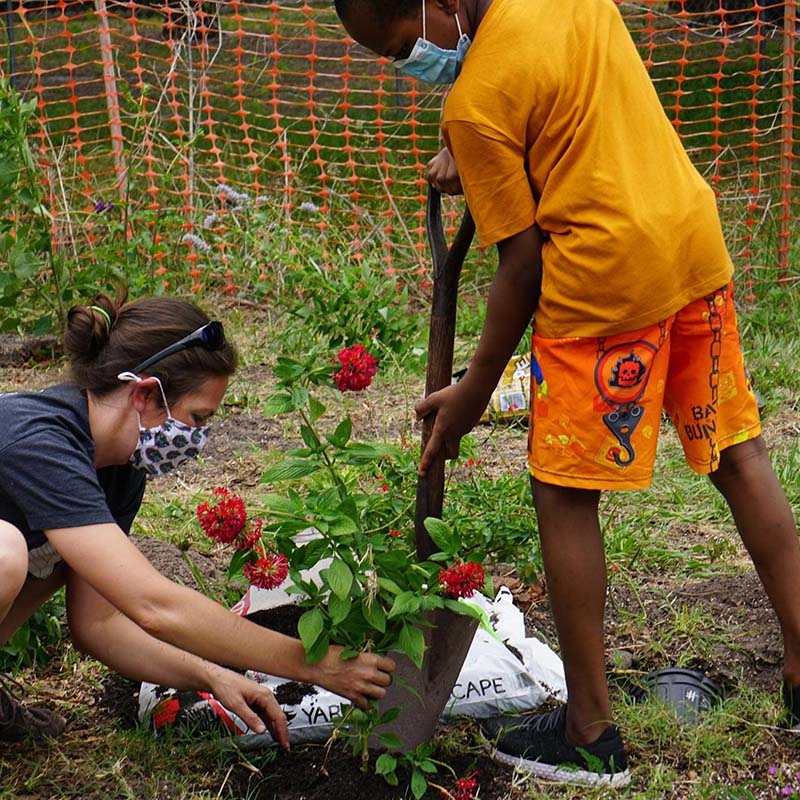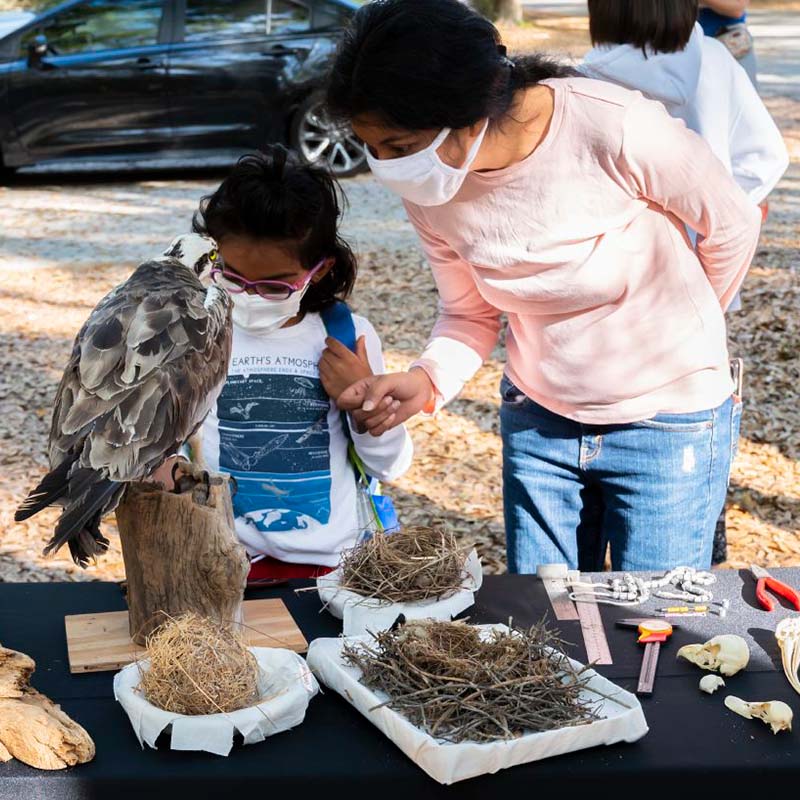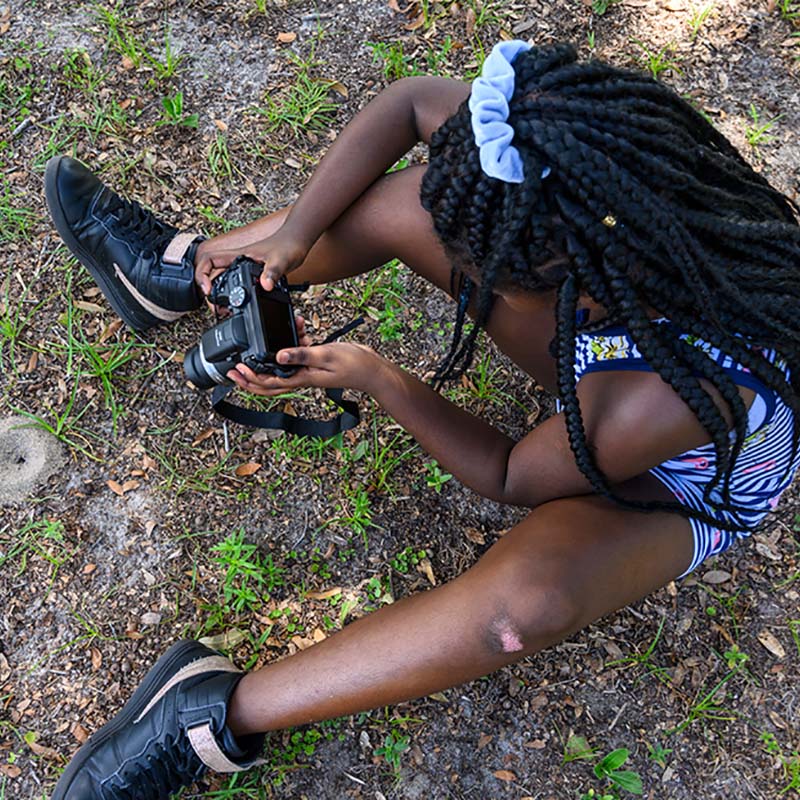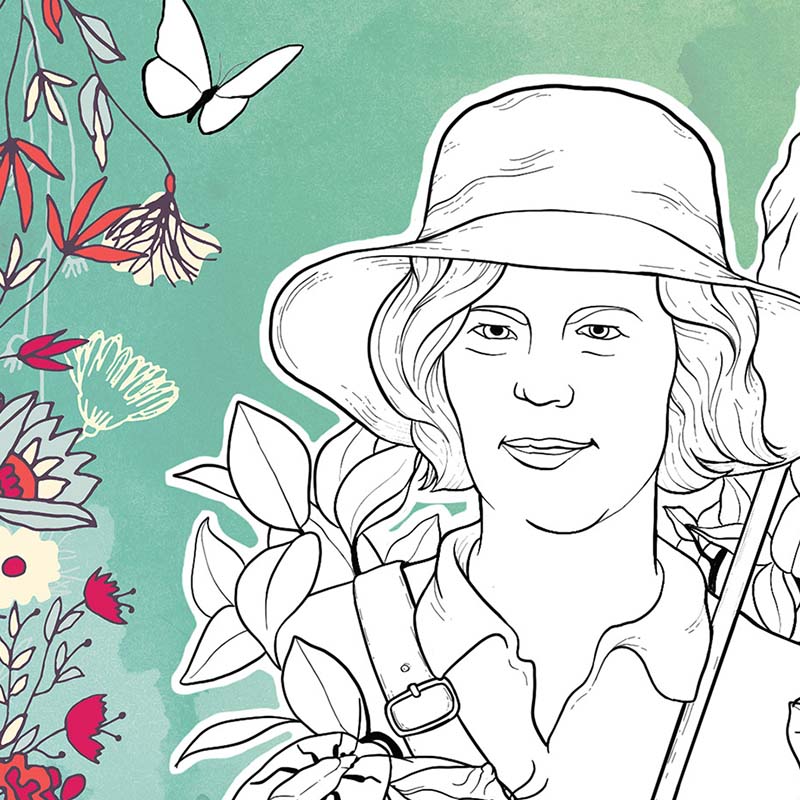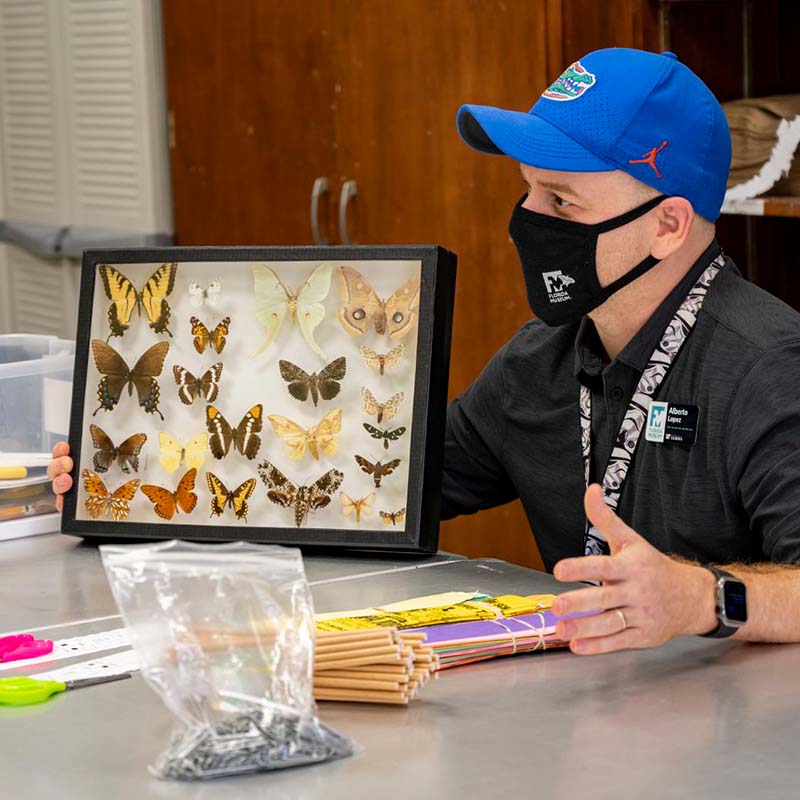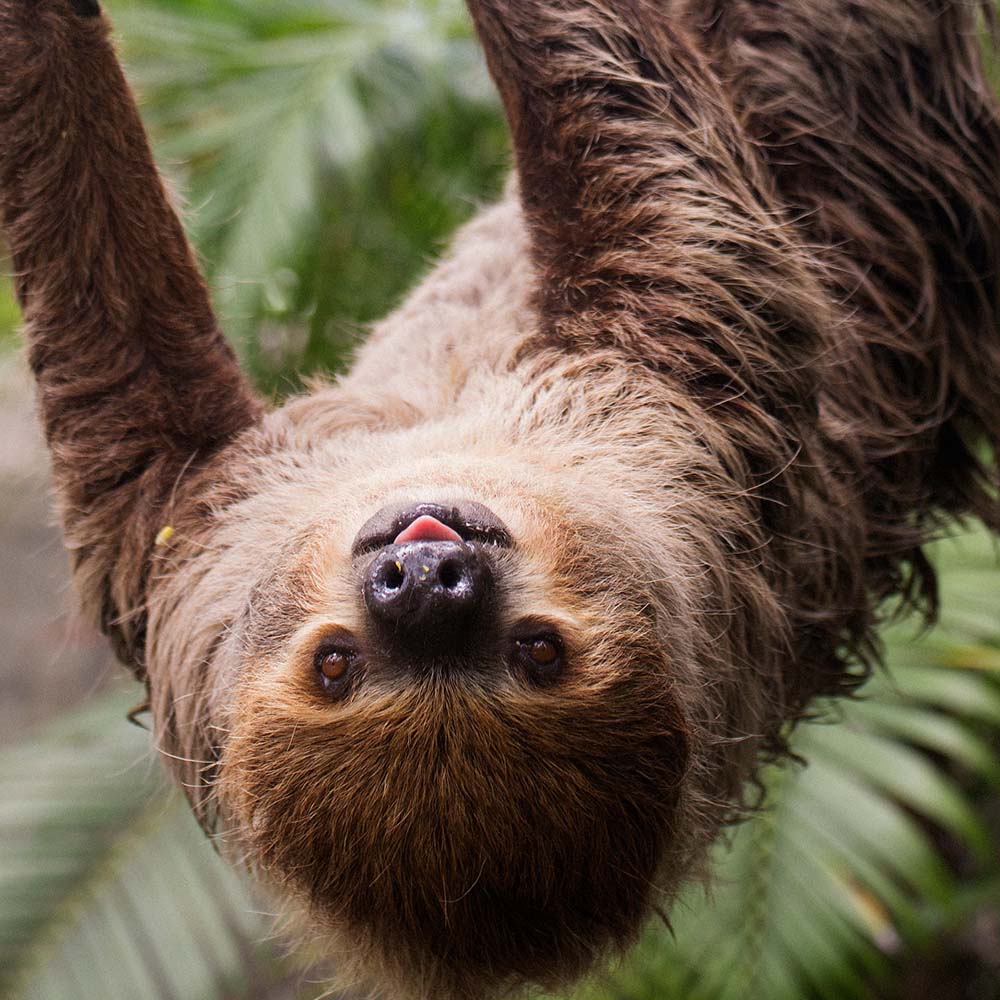The past year was challenging for all of us. Not only did the COVID-19 pandemic touch the lives of almost everyone, but its effects also reverberated throughout the museum community. In fact, the year began with most museums shuttered as the coronavirus spread across the nation and around the world. The American Alliance of Museums estimated that of the approximately 30,000 museums in America, as many as one-quarter to one-third could be at risk of not surviving the pandemic. Thankfully, we were not among them.
The Florida Museum reopened to in-person visitors July 1, 2020. Attendance was initially modest as visitors were hesitant to venture out into public settings. However, strict adherence to Centers for Disease Control and Prevention guidelines and university protocols such as face masks, social distancing, reduced occupation capacities for indoor spaces and vigorous cleaning of high-touch surfaces reassured people that the museum was a safe place to visit. By year’s end, our in-person attendance topped 150,000, about 70% of prepandemic levels.
One of the most exciting things to report this year is that we began construction on our new Special Collections Building.
As visitors returned to the museum, so did faculty, staff and students, many of whom became proficient at working remotely. Our research labs, collection areas, exhibit galleries and offices gradually sprang back to life. Unfortunately, we were forced to make many adjustments in response to the new reality we faced. No school tours or facility rentals meant elimination of these programs. Our popular Discovery Zone was closed all year, and large special events were canceled or reimagined as virtual events. Yet we were able to weather the pandemic challenges in large measure because of the support and guidance provided by our parent organization — the University of Florida.
While the lingering coronavirus influenced our daily operations all year, many exciting developments occurred nonetheless. Our temporary exhibition, Survival of the Slowest, featured many live animals, including Flash the sloth, and turned out to be immensely popular. UF awarded us two new faculty positions in artificial intelligence as part of its Faculty 100 initiative. Jon Bloch was appointed to another three-year term as chair of the department of natural history, and Keith Willmott became director of our McGuire Center. And at our Randell Research Center in southwest Florida, Annisa Karim was hired as the on-site operations manager, replacing Cindy Bear, who will retire this year after many years of dedicated service.
Finally, ’20-’21 saw the groundbreaking for a long-awaited and much-anticipated capital project, our new Special Collections Building. Located just south of Powell Hall and west of the Curtis M. Phillips Center for the Performing Arts, this 23,500-square-foot, purpose-built facility will be completed in 2022 and will house the museum’s “wet collections,” about 4 million to 5 million specimens stored in alcohol. After the project was in the planning stages for decades, UF provided the necessary funding. The state fire marshal, along with our collections and curatorial staffs, are eagerly awaiting its completion.
I hope you enjoy this annual report. Thanks for a great year and for your continuing support.
Douglas S. Jones
Director
Florida Museum of Natural History
Integrated Digitized Biocollections
(iDigBio)
Unlocking collections: iDigBio celebrates 10 years of leading museum digitization
Scientists have collected animals, plants and fungi for hundreds of years, meticulously cataloguing and curating these organisms for posterity. Before the Internet, however, the wealth of information these specimens offered was largely confined to the drawers and shelves of museums and universities. Digitization, the process of uploading key specimen data and imagery to online platforms, compiles this information in a searchable archive of life that can be used by researchers, educators, policymakers and community scientists around the world.
 For the past decade, iDigBio, a collaborative program funded by the National Science Foundation and based at the Florida Museum of Natural History, has led the push to digitize the estimated 1 billion biological specimens held in U.S. museums. These online records of animals, plants and other organisms help researchers identify species in danger of extinction, track the spread of invaders, study how climate change is reshaping ecosystems and possibly predict the next pandemic.
For the past decade, iDigBio, a collaborative program funded by the National Science Foundation and based at the Florida Museum of Natural History, has led the push to digitize the estimated 1 billion biological specimens held in U.S. museums. These online records of animals, plants and other organisms help researchers identify species in danger of extinction, track the spread of invaders, study how climate change is reshaping ecosystems and possibly predict the next pandemic.
Thanks to iDigBio’s coordination, training and community-building efforts, about 40% of specimens in U.S. collections are now represented in the program’s portal, comprising one of the largest virtual collections of life on Earth and contributing to more than 2,000 studies so far.
This year, NSF awarded iDigBio nearly $20 million to continue its mission of digitizing natural history collections nationwide, propelling the next five years of the program’s success, said iDigBio Director Gil Nelson.
“We need to sustain the momentum that has been developed over the last 10 years in the collections community,” he said. “Our goal is to digitize everything we can.”
Read More
iDigBio Status at the End of the Tenth Year
31 (TCNs) and 52 Partners to Existing Networks (PENs) supported, representing 900+ collections in 300+ institutions
131,079,736
Specimen records digitized
122,674,144
Records viewed
5,047,054,652
Records downloaded
43
Graduate students & postdocs trained
18,619
Participants in 482 workshops, symposia & other events
2,235
Studies published
33
Working groups supported
Research & Collections
Department of Natural History Highlights
Despite the pandemic, the Department of Natural History experienced a remarkably productive year. Scientists focused on leveraging existing collections with the help of new technology and large-scale digitization efforts, and fieldwork resumed in the spring after a year of lockdowns. Accomplishments include many high-profile publications and a very successful year bringing in external funding for our collections and research. We quickly pivoted to virtual teaching, meetings, conferences and collaborations, working with colleagues from all over the globe. These platforms have changed how we approach our research collaborations, make our discoveries more accessible and will continue to shape the way we engage into the future.
The Solomon Island leaf frog, Cornufer guentheri, has true teeth on its upper jaw and bony fangs on its lower jaw, which do not have enamel or dentin, a dense tissue found in teeth. ©Florida Museum/Daniel Paluh
Discoveries in collections
Specimens continue to yield surprises long after they are curated. Digitization and DNA analysis uncovered a new species of Florida lichen in the University of Florida Herbarium that had gone misidentified for more than a century. Now the hunt is on to find it in the wild – if it still exists. Digital data also revealed the puzzling backstory of teeth in frogs, showing the group has lost the feature more than 20 times throughout its evolution.
First recorded in 1923, the rare land snail Endodonta christenseni wasn’t formally named or described for almost a century, until researchers rediscovered it through extensive field surveys. Photo courtesy of David Sischo
Documenting life on Earth
For the first time in 60 years, scientists described a new native Hawaiian land snail species, sounding a rare, hopeful note in a story rife with extinction. The same team also rediscovered a snail species long presumed extinct on a remote Hawaiian island. Museum researchers are also identifying the major killers of Florida’s birds, thanks to a collaboration with rehabilitation centers. And scientists were astonished when a survey of sea anemone gut contents revealed an unexpected meal: ants.
These blades represent early Archaic Age technology and were used for cutting, digging, making tools such as spears and points and preparing brush for structures. ©Florida Museum/William Keegan
Revolutions in ancient DNA
Advancements in the study of ancient DNA are redefining what we know about the first people to settle the Caribbean and helping resolve longstanding questions from an archaeologist’s career of more than 40 years. Ancient DNA also uncovered a previously unknown link between Old World birds and Caribbean avian life. A new grant from the National Science Foundation will fund an investigation of how humans have impacted bird diversity and extinctions over time, with specimens from the museum’s archaeological and paleontological collections.
Asian giant hornets (Vespa mandarinia japonica) drinking sap from tree bark in Japan. Alpsdake/Wikipedia, CC BY-SA
Science communication and education
Online programming rapidly expanded across museums during the pandemic, but it comes with challenges. Megan Ennes unpacked why partnerships and professional development are key to these programs’ long-term success. Michelle Lefebvre and David Blackburn’s “Introduction to Natural History Collections” immersed UF graduate students in the inner workings of museums. Akito Kawahara dispelled myths about the sparrow hornet and why nicknames such as “murder hornets” do more harm than good.
After death, ammonites would commonly float due to trapped gas in their shells. Collected by ocean currents, they often washed up and fossilized in groups, like this mass of Deshayesites deshayesi. ©Florida Museum/Jeff Gage
Paleobiology
Computer network modelling overturned the textbook model of what drives major transitions in ocean life, showing battles between predators and prey reshaped the sea as dramatically as mass extinction events. A high school lesson gone wrong led to a new way of estimating how big megalodon was. CT scans of bizarre, armored amphibians provide the earliest evidence of a slingshot-style tongue. Finally, keep an eye out for a new virtual reality game that initiates would-be paleontologists in the joys of collecting and comparing fossils.
New data for Melastomataceae species such as Miconia curvipila, pictured here, will be made publicly available on web resources such as GenBank and iDigBio. ©Florida Museum/Lucas Majure
Advancements in the herbarium
A trio of NSF grants will fuel new discoveries at the UF Herbarium. Using the wildflower genus Lobelia, researchers will study why certain species grow together and make predictions about how climate change could disrupt these patterns. The herbarium is also leading a grant to study Melastomataceae, the eighth largest family of flowering plants on the planet, to understand the evolution of worldwide tropical plant diversity. Another collaboration will result in the digitization of nearly 1.2 million lichens and bryophytes, a group that includes mosses, hornworts and liverworts – organisms often underrepresented in digital collections.
Collections & Research Data
222
Peer-reviewed publications
62
Grants & contracts worth $12 million
119
Undergraduates & postdoctoral fellows working in the collections
40+
Million specimens & artifacts
243,906
New accessions to collections
139,494
New specimens & artifacts cataloged
27,601
Specimens & artifacts loaned via 243 loans
4,300
News articles about museum research with potential readership of 7.8 billion
Research Locations
McGuire Center for Lepidoptera & Biodiversity
Curators and staff with the McGuire Center for Lepidoptera and Biodiversity continued their groundbreaking research focused on the conservation, diversity, ecology and evolution of moths, butterflies and other insects. This year, Keith Willmott was appointed as director of the Center, whose collections continued to grow apace through donations and the efforts of its staff and students.
The feeding behavior of Philodoria auromagnifica caterpillars can cause the leaf they live inside to fall off the plant, which may help protect them from parasitic wasps. ©Florida Museum/Chris Johns
Hawaii Moths
Museum researchers helicoptered onto volcanoes to study gaudy, minuscule moths, discover new species and conserve Hawaiian biodiversity.
Adelpha, a genus of brush-footed butterflies, are fast-flying insects native to the Southern U.S., Mexico and South America. While difficult to catch in flight, they are easy to bait and common in museum collections. ©Florida Museum/Keith Willmott
Escape Artists
Studies of colorful butterflies showed that their bright markings signal to birds not to bother even trying to attack these fast-flying insects.
After mating, male butterflies excrete a pre-molded plug from intricate abdominal ducts that give the plug its complex shape. The plug hardens on the female, blocking her reproductive organs, but not the orifice she uses to lay eggs. Photo by Ana Carvalho
Battle of the Sexes
Male butterflies sometimes attach bizarre winged, flanged or spiky structures on female abdomens to prevent them from mating again. McGuire Center researchers examined who is winning in this battle of the sexes.
The spicebush swallowtail (Papilio troilus) is a spectacular butterfly found in the eastern United States. Adults are iridescent blue and black with orange spots, while caterpillars resemble a snake as a defense mechanism. ©Florida Museum/Andrei Sourakov
Florida Backyard Discoveries
Many mysteries remain to be uncovered among the insects in our own backyards. Collections Coordinator Andrei Sourakov explained how Florida moths can keep invasive plants in check, documented insects that live in hollow trees, and disposed of mountains of poop during ongoing studies of Florida caterpillars.
A Florida Museum volunteer helps students with their planting. Museum staff and volunteers conduct these workshops to educate participants about pollinators and life as researchers, all while establishing a habitat for bees, butterflies and other insects. ©Florida Museum/Kristen Grace
Inspiring the Next Generation
Efforts to inspire the next generation of Lepidoptera researchers included expansion of the museum’s butterfly garden initiative and movement of the popular summer LepCamp to a COVID-friendly, online format.
A marked blue calamintha bee collects pollen from Ashe’s calamint. ©Florida Museum/Jaret Daniels
Conserving Declining Insects
An education and awareness campaign highlighted the current decline of insects, and Associate Curator Akito Kawahara described some simple steps we can take to help reverse this trend. A new exhibit provided stunning close-up images to show ongoing efforts to conserve insects. Curator Jaret Daniels received a grant from the Disney Foundation to continue work on imperiled butterflies, and scientists continued to uncover the secrets of one of Florida’s rarest insects, the blue calamintha bee.
Faculty Promotions
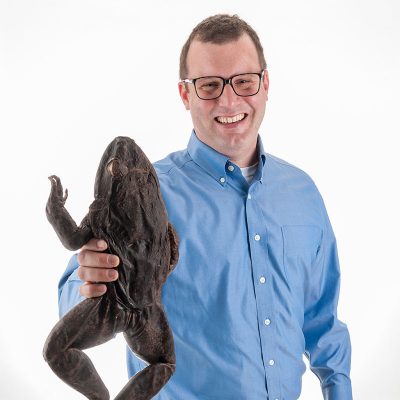
David Blackburn
Curator of Herpetology
Blackburn has worked as a curator at the Florida Museum since 2015, where he’s conducted research on amphibian biodiversity and conservation, with a particular focus on African frogs, and leads the oVert initiative.
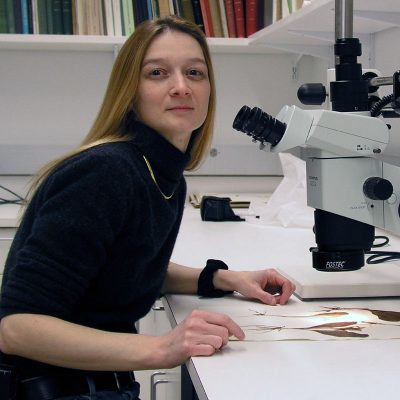
Nico Cellinese
Curator of Informatics
Cellinese’s work is centered around the development of computational tools that aid researchers in cataloging the tree of life. She also studies the evolution and diversification of flowering plants using advanced genomic techniques.
Staff & Faculty Teaching
Graduate committees chaired
Graduate committees served
Independent studies supervised
Courses taught by Museum faculty
New Staff Hires
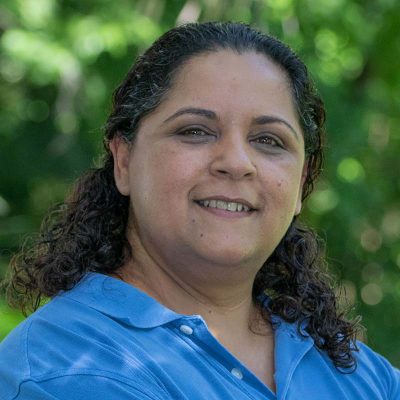
Annisa Karim
Operations Manager, Randell Research Center
Karim manages the day-to-day operations of the archaeological research center in Lee County, in addition to developing educational materials and activities for visitors and students from local schools. Learn more

Aaron Woodruff
Collections Manager II, Vertebrate Paleontology
In his new role, Woodruff oversees the screen washing and fossil collection of small mammals, reptiles and amphibians. He also identifies and curates fossils from Thomas Farm in Gilchrist County.
Staff Retirements
Art Poyer
Collections Manager II, Vertebrate Paleontology
From 1985-2020, Poyer helped to maintain the vertebrate paleontology collection and actively participated in research, fossil digs and community outreach activities.
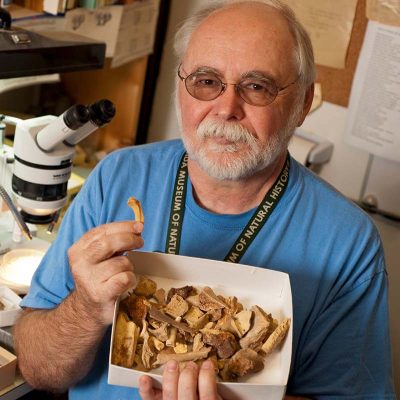
Thomas Webber
Collection Manager, Ornithology
From 1984-2020, Webber helped to manage the museum’s ornithology collection, including conducting research, identifying and preparing new specimens, processing loans and participating in collection expeditions.
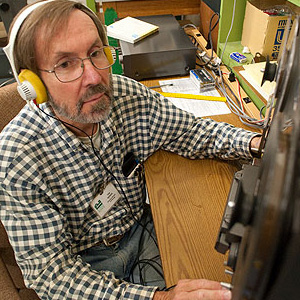
Outreach
Exhibits & Public Programs
On July 1, 2020, the Florida Museum kicked off both the fiscal year and a public reopening following the unprecedented pandemic closure. In a challenging year, the museum played a vital role in welcoming and supporting visitors at a critical time. The Butterfly Rainforest provided beauty and respite, while Megalodon: Largest Shark that Ever Lived and the visiting exhibition Survival of the Slowest engaged audiences in safe, but entertaining, learning. As the pandemic made road trips more popular, the museum welcomed visitors from each of Florida’s 67 counties, all 50 states and 10 other countries.
Programs also provided meaningful community support. While virtual programs continued, in-person programs resumed in outdoor settings. Virtual events such as Science off Tap, Mushrooms at the Museum, speaker and film series, and 360-degree exhibit tours engaged people from all over the state, country and world. The in-person nature-based program Museum in the Parks partnered educators, scientists, state parks and public participants for deep learning on topics such as fish, insects and birds. Outreach events for community partner summer camps and after-school programs provided science learning for youth who might otherwise be unable to visit the museum. Focusing on outreach efforts allowed the museum to reach people where they were, deepen community partnerships, engage youth and families in nature, and expand its strategic outreach goals.
Although the pandemic did not end with the fiscal year, the year did close with stronger and more diverse visitation than in prepandemic times, underscoring the museum’s value to visitors, their families and friends. These visitors also reminded us of the amazing work done by our education, exhibits and front-line teams to keep visitors safe and engaged in unprecedented times. Butterfly Rainforest, security, visitor services and gift shop staff all navigated the complexities of pandemic visitation with dedication and a commitment to excellent customer service. The museum is grateful to all employees for a year of unmatched effort.
Attendance & Outreach Data
150,304
Annual visitation
3,907
Public program participants
88,679
Visitors to Museum traveling exhibits at other venues
807
Youth camp participants
5,333
Youth outreach participants
1,222
School field trip participants
Thompson Earth Systems Institute
The University of Florida Thompson Earth Systems Institute (TESI) continued to advance communication and education about Earth systems science in a way that inspires Floridians to be effective stewards of our planet.
Through digital outreach campaigns, we curated information about Florida’s environment and natural resources and packaged it in a way that is digestible, understandable and solutions-oriented. TESI’s workshops and paid internships focused on the art of sharing science with the public through effective science communication. We helped early-career scientists and aspiring science communicators hone their outreach skills to disseminate science-based information to broader audiences.
TESI’s flagship Scientist in Every Florida School Program, or SEFS, hosted professional development workshops, where teachers were able to work alongside scientists to develop novel, standards-based lesson plans focused on Florida’s environment. The program also coordinated more than 1,700 scientist visits to classrooms in about 500 public schools throughout Florida, reaching 55,000 K-12 students.
TESI faculty, staff and students advanced our vision to lead the way to a healthier planet by cultivating a responsible and curious society that values, trusts and has access to science.
TESI Outreach Data
55,000
K-12 Students representing 400 schools
1,700
SEFS scientist visits
8,000
K-12 students & teachers attend 137 virtual events
1,100
Floridians learn about earth systems through 17 events
50
Professional workshop attendees
$116K
In private funding acquired for SEFS & outreach
Through this campaign, 42,000 Floridians learned why insects are important, the threats they face and how they can be protected. ©Florida Museum/Sadie Mills
Insect Effect
Produced in partnership with museum scientists from the McGuire Center for Lepidoptera and Biodiversity, this campaign used social media and educational videos to spread the word on the problem of insect decline.
Produced in partnership with iDigBio and Florida Museum educators, this workshop helped early career scientists develop valuable science communication skills.
Science & Me
During this virtual summer workshop, 10 UF students from underrepresented communities learned how to develop, film and edit a short video about their journeys to becoming scientists.
EJMI students were mentored by editors from prominent environmental publications where they learned reporting and interviewing skills.
UF Environmental Justice Media Intensive
Hosted in collaboration with the UF Levin College of Law, six science and journalism students teamed up to write stories showing the connections between the environment and social justice issues.
TESI environmental communicators learned storytelling, graphic design, social marketing, data analysis and more.
TESI Environmental Communicators
Through this paid internship, UF undergraduate students developed valuable science communication skills while contributing to TESI’s digital outreach and education about various topics related to the state’s environment.
Earth to Florida and Know Your Florida content garnered 416,000 impressions and 52,000 likes, comments and shares.
Know Your Florida and Earth to Florida
Through these two digital outreach platforms, TESI helped a statewide audience better understand Florida’s environment, natural history and outdoor wonders. The content for both platforms is primarily created by TESI’s student environmental communicators.
So far, the program has coordinated more than 1,700 scientist visits to classrooms in about 500 public schools throughout Florida, reaching 55,000 K-12 students. ©Florida Museum/Rebecca Burton
Scientist in Every Florida School
TESI’s Scientist in Every Florida School Program matched teachers with scientists who delivered lessons via classroom visits and served as role models for the next generation of Floridians.
Museum-wide Digital Engagement Data
8,590,867
Website Pageviews3,373,110
Website Visitors37,076
Main Facebook Likes11,742
Twitter Followers215,847
Pinterest Followers10,135
Instagram Followers4,666
YouTube Subscribers1,134
LinkedIn Followers14,336
Email SubscribersSupport
Ann and Bob Powell Help Plant Seed for Museum Expansion Project
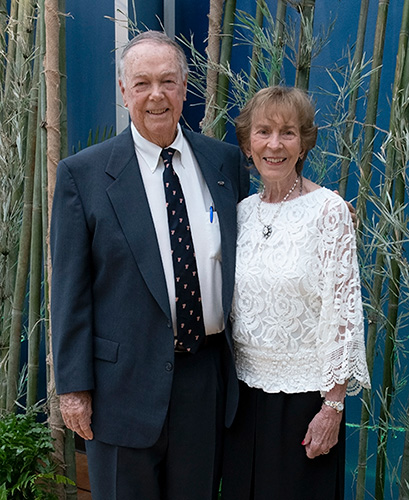
Bob and Ann Powell at the Florida Museum’s 100th Anniversary Gala in 2017. ©Florida Museum/Jeff Gage
As longtime supporters of the Florida Museum of Natural History, Ann Powell and her late husband Bob have made a lead gift to support the Museum’s expansion project, which will include a state-of-the-art education and communications hub to educate diverse audiences about Earth’s air, water, land and life, collectively known as Earth systems. The new facility will house the UF Thompson Earth Systems Institute, an outreach-focused program launched in 2018, a learning theater, a high-tech classroom and an exhibition gallery.
“Since their leadership gift in the 1990s that paved the way for construction of Powell Hall, home to the museum’s exhibits and public programs at the UF Cultural Plaza, Ann and Bob Powell have remained loyal supporters of the Florida Museum,” said Florida Museum director Doug Jones. “Their most recent gift to support our expansion project reflects their belief that this institution is vital to the education and inspiration of the next generation of Floridians.”
Bob grew up in Fort Lauderdale when it was a small beachside town, and Ann grew up in Gainesville. The two met at the University of Florida where Ann majored in education and Bob in civil engineering. After graduation, Bob joined the Air Force as a pilot before returning to Fort Lauderdale to work for his family’s marine and bridge-building business, Powell Brothers, Inc. Ann taught high school for many years before becoming what she describes as a “professional volunteer,” dedicating her time to programs that helped educate and inspire children.
As lifelong Floridians, the Powells have witnessed the environmental changes that continue to challenge the state.
“I love Florida because I was born here and I’ve lived here all my life, never considered living any place else,” Ann said, explaining that Bob was an avid outdoorsman who loved hunting and fishing. The two often spent time in their cabin in the woods near Okeechobee. With Ann’s passion for education and Bob’s love of nature, the couple was enthusiastic about supporting this exciting endeavor.
With their gift, many more Floridians and visitors to the state will be inspired to be effective stewards of the planet, allowing future generations to cherish Florida’s nature.
Volunteer Hours
Hours donated
Total volunteers
Fundraising Data
$40,495,758
Total Gifts FY 20-21
$35,056,865
Total Endowment Value
-
Cash Gifts
-
Gifts in Kind
-
Bequests
-
Other Pledges
| Cash Gifts | $5,279,012 | 13% |
| Gifts in Kind | $1,310,881 | 3% |
| Bequests | $33,425,865 | 83% |
| Other Pledges | $480,000 | 1% |
Financials
Revenue
$36.01M
-
UF and State Allocation
-
Investment Income
-
Contracts and Grants
-
Gifts
-
Earned Income
-
Other UF Income
| UF/State Allocation | $13.53M | 37.56% |
| Investment Income | $8.57M | 23.81% |
| Contracts and Grants | $5.76M | 16.00% |
| Gifts | $5.28M | 14.66% |
| Earned Income | $1.66M | 4.61% |
| Other UF Income | $1.21M | 3.36% |
Expenses
$22.08M
-
Salaries and Benefits
-
Other Operating Expenses
-
Overhead and Other Fees
-
Transfers for Future Programming
| Salaries & Benefits | $16.58M | 75.10% |
| Other Operating Expenses | $3.23M | 14.65% |
| Overhead/Other Fees | $1.75M | 7.91% |
| Transfers for Future Programming | $0.52M | 2.34% |
Awards & Honors
UF Research Foundation Professor
Robert Guralnick
UF Excellence Award for Assistant Professors
Lucas Majure
2021 Neptunea Award for service to malacology, conchology
Roger Portell
Thea Award, Themed Entertainment Association (TEA), Amazing Pollinators exhibit
Exhibits Team
2021 Austin Award
Ian Ausprey
2021 Austin Award
Ana Paula dos Santos de Carvalho
2021 Bullen Award
Lisa Duffy
2021 Silver winner, SEMC, digital annual report
Communications Team
Publications
- Agafonov, V.A., A.P. Laktionov, Yu.E. Alexeev, and E.V. Mavrodiev. 2020. A new species of Alopecurus (Poaceae) from Central European Russia. Feddes Repertprium 131:141-145. DOI:10.1002/fedr.201900021.
- Aiello, B., M. Tan, U.B. Sikandar, A.J. Alvey, B. Bhinderwala, K.C. Kimball, J.R. Barber, C.A. Hamilton, A.Y. Kawahara, and S. Sponberg. 2021. Adaptive shifts underlie the divergence in wing morphology in bombycoid moths. Proceedings of the Royal Society B 288:0677. DOI:https://doi.org/10.1098/rspb.2021.0677.
- Amarasinghe, P., S. Joshi, N. Page, L.S. Wijedasa, M. Merello, H. Kathriarachchi, R.D. Stone, W. Judd, U. Kodandaramaiah, and N. Cellinese. 2021. Evolution and biogeography of Memecylon. American Journal of Botany 108:628-646. DOI:10.1002/ajb2.1624.
- An, J., Q. Xi, and G. Paulay. 2021. Two new species and a new record of Bopyrinae (Isopoda: Bopyridae) infesting Alpheidae and Hippolytidae, with comments on the genus Bopyrina Kossmann, 1881. Systematic Parasitology 98:155-165. DOI:10.1007/s11230-021-09968-2.
- An, J., Y. Bai, and G. Paulay. 2020. A review of the genus Parioninella (Epicaridea, Bopyridae, Pseudioninae), with description of a new species. Crustaceana 93:1503-1511. DOI:10.1163/15685403-00003940.
- Arakaki, M., P. Speranza, P.S. Soltis, and D.E. Soltis. 2021. Examination of reticulate evolution involving Haageocereus and Espostoa. Haseltonia 27:102-112. DOI:10.2985/026.027.0112.
- Ausprey, I.J., F.L. Newell, and S.K. Robinson. 2020. Adaptations to light predict the foraging niche and disassembly of avian communities in tropical countrysides. Ecology 102(1):e03213. DOI:https://doi.org/10.1002/ecy.3213.
- Bardua, C., A. Fabre, J. Clavel, M.B. Bon, K. Das, E.L. Stanley, D.C. Blackburn, and A. Goswami. 2021. Size, microhabitat, and loss of larval feeding drive cranial diversification in frogs. Nature Communications 12:2503. DOI:10.1038/s41467-021-22792-y.
- Barry, S.C., A.C. Hyman, C.A. Jacoby, L.K. Reynolds, M. Kowalewski, and T.K. Frazer. 2021. Variation in seagrass-associated macroinvertebrate communities along the Gulf coast of peninsular Florida: An exploration of patterns and ecological consequences. Frontiers in Marine Science 8:596966. DOI:https://doi.org/10.3389/fmars.2021.596966.
- Bell, C.J., J.D. Daza, E.L. Stanley, and R.J. Laver. 2021. Unveiling the elusive: X-rays bring scolecophidian snakes out of the dark. The Anatomical Record 304(10):2110-2117. DOI:10.1002/ar.24729.
- Blackburn, D.C., C.A.H. Morales, D.J. Paluh, and E.L. Stanley. 2021. Predation on a gymnopthlamid lizard by the Brazilian Dumpy Frog, Stereocyclops incrassatus (Microhylidae, Gastrophryninae). Herpetology Notes 14:847-849.
- Blackburn, D.C., S.V. Nielsen, M.F. Barej, J. Doumbia, M. Hirschfeld, N.G. Kouamé, D. Lawson, S. Loader, C. Ofori-Boateng, E.L. Stanley, and M.-O. Rödel. 2020. Evolution of the African slippery frogs (Anura: Conraua), including the world’s largest living frog. Zoologica Scripta 49:684-696. DOI:https://doi.org/10.1111/zsc.12447.
- Bloch, L.C. and E. Bollwerk. 2020. Sourcing coarse earthenware at Morne Patate: The impacts of French colonialism and local exchange. pp. 129-152. In: Hauser and D. Wallman, eds. Archaeology in Dominica: Everyday Ecologies and Economies at Morne Patate. University of Florida Press, Gainesville. DOI:https://muse.jhu.edu/book/78047.
- Bloch, L.C., J. Hosen, E. Kracht, M.J. LeFebvre, C.J. Lopez, R. Woodcock, and W.F. Keegan. 2021. Is it better to be objectively wrong or subjectively right? Testing the accuracy and consistency of the Munsell Capsure Spectrocolorimeter for archaeological applications. Advances in Archaeological Practice 9(2)132-144. DOI:10.1017/aap.2020.53.
- Boileau, A., N. Delsol, and K.F. Emery. 2020. Human-animal relations in the Maya world. pp.164-182. In: S.R. Hutson and T. Ardren, eds. The Maya World. Routledge, New York. DOI:https://doi.org/10.4324/9781351029582.
- Bolet, A., E.L. Stanley, J.D. Daza, J. Salvador Arias, A. Čerňanský, M. Vidal-García, J.J. Bevitt, A. Peretti, and S.E. Evans. 2021. Unusual morphology in the mid-Cretaceous lizard Oculudentavis. Current Biology 31:1-12. DOI:10.1016/j.cub.2021.05.040.
- Braatz, E.Y., Z.J. Gezon, K. Rossetti, L.T. Maynard, J. Bremer, G. Hill, and J.C. Daniels. 2021. Bloom evenness modulates the influence of bloom abundance on insect community structure in suburban gardens. PeerJ 9:e11132. DOI:10.7717/peerj.11132.
- Breslin, P., M. Wojciechowski, and L.C. Majure. 2021. Molecular phylogeny of the Mammilloid clade (Cactaceae) of Baja California and adjacent regions: Resolving the monophyly of Mammillaria with new combinations in Cochemiea. Taxon 70(2):308-323. DOI:10.1002/tax.12451.
- Bright, J., C. Ebert, M. Kosnik, J. Southon, K. Whitacre, P. Albano, C. Flores, T.K. Frazer, Q. Hua, M. Kowalewski, J.C. Martinelli, D. Oakley, W.G. Parker, M. Retelle, M. Ritter, M.M. Rivadeneira, D. Scarponi, Y. Yanes, M. Zuschin, and D.S. Kaufman. 2021. Comparing direct carbonate and standard graphite 14C determinations of biogenic carbonates. Radiocarbon 63:387-403. DOI:https://doi.org/10.1017/RDC.2020.131.
- Buckeridge, J.S., J.T. Carlton, R.J. van Syoc, Y. Achituv, R.T. Bauer, L. Buhl-Mortensen, B.K.-K. Chan, G. Coletti, A. Collareta, M.J. Grygier, M.E. Hendrickx, J.T. Høeg, D.S. Jones, F. Kerckof, T. Koči, G.A. Kolbasov, J.E. Laguna, R.T. Perreault, F.B. Pitombo, O.P. Poltarukha, R.W. Portell, G. House, E.C. Southward, H.R. Spivey, J.D. Standing, J.P. Wares, and T. Yamaguchi. 2021. William Anderson Newman (November 13, 1927 – December 26, 2020) in memory of the distinguished invertebrate zoologist, and mentor, colleague and friend. Proceedings of the California Academy of Sciences, Series 4 67(3):55-83.
- Cai, S., Y. Huang, F. Chen, X. Zhang, E. Sessa, C. Zhao, D.B. Marchant, D. Xue, G. Chen, F. Dai, J.H. Leebens‐Mack, G. Zhang, S. Shabala, J.M. Christie, M.R. Blatt, E. Nevo, P.S. Soltis, D.E. Soltis, P.J. Franks, F. Wu, and Z. Chen. 2021. Evolution of rapid blue‐light response linked to explosive diversification of ferns in angiosperm forests. New Phytologist 230(3):1201-1213. DOI:10.1111/nph.17135.
- Carrillo-Briceño, J.D., R. Sánchez, T.M. Scheyer, J.D. Carrillo, M. Delfino, G.L. Georgalis, L. Kerber, D. Ruiz-Ramoni, J.L.O. Birindelli, E.A. Cadena, A.F. Rincón, M. Chavez-Hoffmeister, A.A. Carlini, M.R. Carvalho, R. Trejos-Tamayo, F. Vallejo, C. Jaramillo, D.S. Jones, and M.R. Sánchez-Villagra. 2021. A Pliocene-Pleistocene continental biota from Venezuela. Swiss Journal of Palaeontology 140(9):1-76. DOI:10.1186/s13358-020-00216-6.
- Carvalho, A.P.S., R.A. St Laurent, E.F.A. Toussaint, C.G. Storer, K.M. Dexter, K. Aduse-Poku, and A.Y. Kawahara. 2021. Is sexual conflict a driver of speciation? A case study with a tribe of Brush-footed butterflies. Systematic Biology 70(3):413-420. DOI:10.1093/sysbio/syaa070.
- Ceballos-Izquierdo, Y., L.W. Viñola-López, C.R. Borges-Sellén, and A.F. Arano-Ruiz. 2021. Late Cretaceous sharks from Cuba, first record of Serratolamna serrata (Agassiz)(Lamniformes, Serratolamnidae). Geobios 65:1-6. DOI:https://doi.org/10.1016/j.geobios.2021.01.002.
- Cellinese, N., S. Conix, and H. Lapp. 2021. Phyloreferences: Tree-native, reproducible, and machine-interpretable taxon concepts. Philosophy, Theory and Practice in Biology Online Early. DOI:https://doi.org/10.32942/osf.io/57yjs.
- Ceríaco, L.M.P., M.P. Marques, I. André, E. Afonso, D.C. Blackburn, and A.M. Bauer. 2020. The Museu do Dundo, Angola: An illustrated type catalogue of a “lost” herpetological collection. Bulletin of the Museum of Comparative Zoology 162:379-440. DOI:https://doi.org/10.3099/0027-4100-162.7.379.
- Chen, Z.H. and D.E. Soltis. 2020. Evolution of environmental stress responses in plants. Plant, Cell & Environment. 43:2827-2831. DOI:10.1111/pce.13922.
- Cheng, L., P. Antonenko, A.D. Ritzhaupt, and B.J. MacFadden. 2021. Exploring the role of 3D printing and STEM integration in students’ STEM career interests. British Journal of Educational Technology 52(3)1262-1278. DOI:10.1111/bjet.13077.
- Ciccotto, P.J. and L.M. Page. 2020. Revision of the genus Henicorhynchus with a revised diagnosis of Gymnostomus (Cyprinidae: Labeoninae). Copeia 108(3):485-502. DOI:10.1643/CI-19-304.
- Cobb, C.R. 2020. Commentary on where is the Southeastern native American economy? Southeastern Archaeology 39(4):293-294.
- Cobb, C.R. 2021. Archaeology’s offerings to Jesuit history. Journal of Jesuit Studies 8:460-468.
- Cobb, C.R. and D.W. Steadman. 2021. Warfare and structural violence in Mississippian-Period Southeastern North America. pp. 375-388. In: A. Abar, M.B. D’Anna, G. Cyrus, V. Egbers, B. Huber, C. Kainert, J. Köhler, B. Öğüt, N. Rol, G. Russo, J. Schönicke, and F. Tourtet, eds. Pearls, Politics, and Pistachios. Ex Orient, Berlin. DOI:https://doi.org/10.1007/978-3-319-18506-4_5.
- Colella, J.P., B.R. Agwanda, F.A.A. Khan, J. Bates, C.A. Carrión Bonilla, N.U. de la Sancha, J.L. Dunnum, A.W. Ferguson, S.E. Greiman, P.K. Kiswele, E.P. Lessa, P.S. Soltis, C.W. Thompson, M.P.M. Vanhove, P.W. Webala, M. Weksler, and J.A. Cook. 2020. Build international biorepository capacity. Science 370:773-774. DOI:10.1126/science.abe4813.
- Collin, R., D. Venera-Pontón, G. Paulay, and M.J. Boyle. 2020. World travelers: DNA barcoding unmasks the origin of cloning asteroid larvae from the Caribbean. Biological Bulletin 239:73-79. DOI:10.1086/710796.
- Cong, Q., J. Shen, J. Zhang, W. Li, L.N. Kinch, J.V. Calhoun, A.D. Warren, and N.V. Grishin. 2021. Genomics reveals the origins of historical specimens. Molecular Biology and Evolution 38(5):2166-2176. DOI:10.1093/molbev/msab013.
- Cook, J.A., S. Arai, B. Armién, J. Bates, C.A. Carrion Bonilla, M.B. de Souza Cortez, J.L. Dunnum, A.W. Ferguson, K.M. Johnson, F.A.A. Khan, D.L. Paul, D.M. Reeder, M.A. Revelez, N.B. Simmons, B.M. Thiers, C.W. Thompson, N.S. Upham, M.P.M. Vanhove, P.W. Webala, M. Weksler, R. Yanagihara, and P.S. Soltis. 2020. Integrating biodiversity infrastructure into pathogen discovery and mitigation of emerging infectious diseases. BioScience 70:531-534. DOI:https://doi.org/10.1093/biosci/biaa064.
- Correa-Narvaez, J.E. and S.R. Manchester. 2021. Distribution and morphological diversity of Palaeocarpinus (Betulaceae) from the Paleogene of the Northern Hemisphere. The Botanical Review 2021. DOI:https://doi.org/10.1007/s12229-021-09258-y.
- Crawford, C.H., Z.S. Randall, P.B. Hart, L.M. Page, P. Chakrabarty, A. Suvarnaraksha, and B.E. Flammang. 2020. Skeletal and muscular pelvic morphology of hillstream loaches (Cypriniformes: Balitoridae). Journal of Morphology 281:1290-1295. DOI:10.1002/jmor.21247.
- Cunningham-Smith, P. and K.F. Emery. 2020. Dogs and people: Exploring the human-dog connection. Journal of Ethnobiology 40(4):409-413. DOI:https://doi.org/10.2993/0278-0771-40.4.409.
- Cunningham-Smith, P., A.E. Sharpe, A. Boileau, E.K. Thornton, and K.F. Emery. 2020. Food, friend, or offering: Exploring the role of Maya dogs in the zooarchaeological record. pp. 161-187. In: T. Ardren, ed. “Her Cup for Sweet Cacao”: The Social Uses of Food in Ancient Maya Society. University of Texas Press, Austin. DOI:https://doi.org/10.2993/0278-0771-40.4.409.
- Daniell, H., S. Jin, X.-G. Zhu, M.A. Gitzendanner, D.E. Soltis, and P.S. Soltis. 2021. Green giant—a tiny chloroplast genome with mighty power to produce high-value proteins: History and phylogeny. Plant Biotechnology Journal 19:430-447. DOI:https://doi.org/10.1111/pbi.13556.
- Daniels, J.C. 2020. Native Plant Gardening for Birds, Bees & Butterflies: Southeast (Nature-Friendly Gardens). Adventure Publications. Cambridge, MN. 276 pp.
- Daniels, J.C. 2021. Insects & Bugs Backyard Workbook: Hands-on Projects, Quizzes, and Activities for Kids (Nature Science Workbooks for Kids). Adventure Publications. Cambridge, MN. 96 pp.
- Daniels, J.C. 2021. Insects & Bugs for Kids: An Introduction to Entomology (Simple Introductions to Science). Adventure Publications. Cambridge, MN.
- Daniels, J.C. 2021. Wildflowers of the South & Southeast: Your Way to Easily Identify Wildflowers (Adventure Quick Guides). Adventure Publications. Cambridge, MN. 22 pp.
- Daza J.D., E.L. Stanley, A. Bolet, A.M. Bauer, A.J. Salvadore Arias, A. Cernasky, J. Bevitt, P. Wagner, and S.E. Evans. 2020. Enigmatic amphibians in mid-Cretaceous amber were chameleon-like and had ballistic feeding. Science 370(6517):687-691. DOI:10.1126/science.abb6005.
- De Souza Cortez, M.B., R.A. Folk, C.J. Grady, J.P. Spoelhof, S.A. Smith, D.E. Soltis, and P.S. Soltis. 2020. Is the age of plant communities predicted by the age, stability and soil composition of the underlying landscapes? An investigation of OCBILs. Biological Journal of the Linnean Society 133(2):297-316. DOI:https://doi.org/10.1093/biolinnean/blaa174.
- Delsol, N. 2020. Disassembling cattle and enskilling subjectivities: Butchering techniques and the emergence of new colonial subjects in Santiago de Guatemala. Journal of Social Archaeology 20(2):189-213. DOI:https://doi.org/10.1177/1469605320906910.
- Duke, C.T., T.J. Pluckhahn, and J.M. Compton. 2020. Intensification revisited: Assessing resource specialization at Crystal River (8CI1) and Roberts Island (8CI41), Florida. Southeastern Archaeology 39:198-217. DOI:https://doi.org/10.1080/0734578X.2020.1752612.
- Earl, C., M.W. Belitz, S.W. Laffan, V. Barve, N. Barve, D.E. Soltis, J.M. Allen, P.S. Soltis, B.D. Mishler, A.Y. Kawahara, and R.P. Guranick. 2021. Spatial phylogenetics of butterflies in relation to environmental drivers and seed plant diversity in North America. iScience 24(4):102239. DOI:10.1016/j.isci.2021.102239.
- Ellis, E.A., C.G. Storer, and A.Y. Kawahara. 2021. De novo genome assemblies of butterflies. GigaScience 10(6):giab041. DOI:10.1093/gigascience/giab041.
- Ennes, M. 2021. Museum-based distance learning programs: Current practices and future research opportunities. International Review of Research in Open and Distributed Learning. 22(2):242-260. DOI:10.19173/irrodl.v22i2.5225.
- Ennes, M. and M.G. Jones. 2021. Building a science community: Family science programs. Science Scope 44(4). https://www.nsta.org/science-scope/science-scope-marchapril-2021/building-science-community.
- Ennes, M., D. Lawson, K. Stevenson, M.N. Peterson, and M.G. Jones. 2021. It’s about time: Perceived barriers to in-service teacher climate change professional development. Environmental Education Research 27(5)762-778. DOI:10.1080/13504622.2021.1909708.
- Ennes, M., M.G. Jones, and K. Chesnutt. 2020. Evaluation of educator self-efficacy in informal science centers. Journal of Museum Education 45(3):327-339. DOI:10.1080/10598650.2020.1771993.
- Evangelista, D.A., S. Simon, M.M. Wilson, A.Y. Kawahara, M.K. Kohli, J.L. Ware, B. Wipfler, O. Bethoux, P. Grandcolas, and F. Legendre. 2021. Assessing support for Blaberoidea phylogeny suggests optimal locus quality. Systematic Entomology 46(1):157-171. DOI:10.1111/syen.12454.
- Feiner, N., I.S.C. Jackson, E.L. Stanley, and T. Uller. 2021. Evolution of the locomotor skeleton in Anolis lizards reflects the interplay between ecological opportunity and phylogenetic inertia. Nature Communications 12:1525. DOI:https://doi.org/10.1038/s41467-021-21757-5.
- Fernandes, D.M., K.A. Sirak, H. Ringbauer, J. Sedig, N. Rohland, O. Cheronet, M. Mah, S. Mallick, I. Olalde, B.J. Culleton, N. Adamski, R. Bernardos, G. Bravo, N. Broomandkhoshbacht, K. Callan, F. Candilio, L. Demetz, K.S.D. Carlson, L. Eccles, S. Freilich, A.M. Lawson, K. Mandl, F. Marzaioli, J. Oppenheimer, K.T. Özdogan, C. Schattke, K. Stewardson, F. Terrasi, F. Zalzala, C.A. Antúnez, E.V. Canosa, R.H. Colten, A. Cucina, F. Genchi, C. Kraan, F. La Pastina, M. Lucci, M. Veloz Maggiolo, B. Marcheco-Teurel, C.T. Maria, C. Martinez, I. París, M.P. Pateman, T. Simms, C.G. Sivoli, M.G. Vilar, D.J. Kennett, W.F. Keegan, A. Coppa, M. Lipson, R. Pinhasi, and D. Reich. 2020. A genetic history of the pre-contact Caribbean. Nature 590:103-110. DOI:https://doi.org/10.1038/s41586-020-03053-2.
- Figueroa, H.F., H. Marx, M.B. de Souza Cortez, C.J. Grady, N.J. Engle-Wrye, J. Beach, A. Stewart, R.A. Folk, D.E. Soltis, P.S. Soltis, and S.A. Smith. 2021. Contrasting patterns of phylogenetic diversity and alpine specialization across the alpine fora of the American mountain range system. Alpine Botany 2021. DOI:https://doi.org/10.1007/s00035-021-00261-y.
- Fisher, E., N. Cobb, A.Y. Kawahara, J. Zaspel, and A. Cognato. 2021. Decline of amateur Lepidoptera collectors threatens the future of Big Data science. BioScience 71(4):396-404. DOI:https://doi.org/10.1093/biosci/biaa152.
- Folk, R.A., H.R. Kates, R. LaFrance, D.E. Soltis, P.S. Soltis, and R.P. Guralnick. 2021. High-throughput methods for efficiently building massive phylogenies from natural history collections. Applications in Plant Sciences 9(2):e11410. DOI:10.1002/aps3.11410.
- Folk, R.A., C.M. Siniscalchi, D.E. Soltis. 2020. Angiosperms at the edge: Extremity and diversity. Plant, Cell & Environment 43:2871-2893. DOI:10.1111/pce.13887.
- Fontenele, R.S., A. Bhaskara, I.N. Cobb, L.C. Majure, A.M. Salywon, J.A. Avalos-Calleros, G.R. Arguello-Astorga, K. Schmidlin, P. Roumagnac, S.G. Ribeiro, S. Kraberger, D.P. Martin, P. Lefeuvre, and A. Varsani. 2021. Identification of the begomoviruses squash leaf curl virus and watermelon chlorotic stunt virus in various plant samples in North America. Viruses 13:810. DOI:10.3390/v13050810.
- Fontenele, R.S., A.M. Salywon, L.C. Majure, I.N. Cobb, A. Bhaskara, J.A. Avalos-Calleros, G.R. Argüello-Astorga, K. Schmidlin, A. Khalifeh, K. Smith, J. Schreck, M.C. Lund, M. Kohler, M.F. Wojciechowski, W.C. Hodgson, R. Puente-Martinez, K. Van Doorslaer, S. Kumari, K.A. Oyeniran, C. Verniere, D. Filloux, P. Roumagnac, P. Lefeuvre, S.G. Ribeiro, S. Kraberger, D.P. Martin, and A. Varsani. 2021. New world Cactaceae plants harbor diverse geminiviruses. Viruses 13(4):694. DOI:10.3390/v13040694.
- Fontenele, R.S., P. Roumagnac, C. Richet, S. Kraberger, D. Stainton, M. Aleamotuá, D. Filloux, P. Bernardo, G.W. Harkins, J. McCarthy, L.S. Charles, N.S. Lamas, E.F.M. Abreau, R.A. Abreau, G.B. Batista, A.L.M. Lacerda, A. Salywon, M.F. Wojciechowski, L.C. Majure, D.P. Martin, S.G. Ribeiro, P. Lefeuvre, and A. Varsani. 2020. Diverse genomoviruses representing twenty-nine species identified associated with plants. Archives of Virology 165:2891-2901. DOI:10.1007/s00705-020-04801-5.
- Fragnière, Y., Y.G. Song, L. Fazan, S.R. Manchester, G. Garfì, and G. Kozlowski. 2021. Biogeographic overview of Ulmaceae: Diversity, distribution, ecological preferences, and conservation status. Plants 10(6). DOI:10.3390/plants10061111.
- Franz, R. 2021. A fascination with Rice Creek. Journal of Florida Studies. 1(9). http://www.journaloffloridastudies.org/files/vol0109/franz-fascination-rice-creek.pdf.
- García-Díaz, J.J., A. Turrent-Carriles, and A.D. Warren. 2021. Panoquina luctuosa luctuosa (Herrich-Schaffer, 1869): A new record for Mexico (Lepidoptera: Hesperiidae: Hesperiinae). Tropical Lepidoptera Research 31(1):1-6. DOI:https://doi.org/10.5281/zenodo.4721592.
- Gaviria-Ortiz, F.G., D.R. Dolibaina, E. Carneiro, A.D. Warren, O.H.H. Mielke, and M.M. Casagrande. 2020. A review of the Neotropical skipper genus Sodalia Evans, 1955 (Lepidoptera: Hesperiidae: Hesperiinae) with the description of a new species. Zootaxa 4877(1):102-124. DOI:10.11646/zootaxa.4877.1.4.
- Gerlach, J., G. Barker, C. Bick, P. Bouchet, G. Brodie, C. Christensen, T. Collins, T. Coote, R. Cowie, G.C. Fiedler, O. Griffiths, V. Florens, K. Hayes, J. Kim, J.-Y. Meyer, W. Meyer, I. Richling, J. Slapcinsky, L. Winsor, and N. Yeung. 2020. Negative impacts of invasive predators used as biological control agents against the pest snail Lissachatina fulica: The snail Euglandina ‘rosea’ and the flatworm Platydemus manokwari. Biological Invasions 23:997-1031. DOI:10.1007/s10530-020-02436-w.
- Goodman, C.M., G.F.M. Jongsma, J.E. Hill, E.L. Stanley, Q.M. Tuckett, D.C. Blackburn, and C.M. Romagosa. 2021. A case of mistaken identity: Genetic evidence and anatomical evidence reveal the cryptic invasion of Xenopus tropicalis in central Florida. Journal of Herpetology 55:62-69. DOI:https://doi.org/10.1670/20-083.
- Granja-Fernández, R., T. Pineda-Enríquez, F.A. Solís-Marín, and A. Laguarda-Figueras. 2020. Ophioderma hendleri sp. nov. (Echinodermata: Ophiuroidea: Ophiodermatidae) and its congeners from the Eastern Pacific. European Journal of Taxonomy 729:11-41. DOI:10.5852/ejt.2020.729.1187.
- Greene, A.H., D.B. Miller, D. Rubadou, R.H. Robins, and D.A. Steen. 2020. Nerodia clarkii compressicauda (Mangrove Saltmarsh Watersnake) Diet. Herpetological Review 51(4):2020.
- Greke, K. and J. Slapcinsky. 2021. New Taheitia H. et A. Adams, 1863, with revisional notes on the Papuan Truncatellidae (Caenogastropoda: Truncatelloidea). pp. 135-184. In: D. Telnov, M.V.L. Barclay, and O.S.G. Pauwels, eds. Biodiversity, Biogeography and Nature Conservation in Wallacea and New Guinea, Vol. 4. The Entomological Society of Latvia, Rīga, 443 pp.
- Hamilton, J.P., G.T. Godden, E. Lanier, W.W. Bhat, T.J. Kinser, B. Vaillancourt, H. Wang, J.C. Wood, J. Jiang, P.S. Soltis, D.E. Soltis, B. Hamberger, and C.R. Buell. 2020. Generation of a chromosome-scale genome assembly of the insect-repellent terpenoid-producing Lamiaceae species, Callicarpa americana. GigaScience 9:giaa093. DOI:https://doi.org/10.1093/gigascience/giaa093.
- Hanna, J.A., M.P. Pateman, L.C. Bloch, and W.F. Keegan. 2021. Human-environment interactions in a Bahamian dune landscape: A geoarchaeological study of a new Lucayan burial site. Geoarchaeology 36(5):789-807. DOI:10.1002/gea.21866.
- Harrison, S.P., R. Schoen, D. Atcitty, R. Fiegener, R. Goodhue, K. Havens, C.C. House, R.C. Johnson, E. Leger, V. Lesser, J. Opsomer, N. Shaw, D.E. Soltis, S. Swinton, E. Toth, and S.A. Young. 2020. Preparing for the need for a supply of native seed. Ecological Restoration 38:203-206. DOI:10.3368/er.38.4.203.
- Hayes, K., J. Slapcinsky, D. Sischo, J. Kim, and N. Yeung. 2020. The last known Endodonta species? Endodonta christenseni sp. nov. (Gastropoda: Endodontidae). Bishop Museum Occasional Papers 138:1-15.
- Heinicke, M.P., J.E. Titus-McQuillan, J.D. Daza, E.M. Kull, E.L. Stanley, and A.M. Bauer. 2020. Phylogeny and evolution of unique skull morphologies in dietary specialist African Shovel-snouted snakes (Lamprophiidae: Prosymna). Biological Journal of the Linnean Society 131(1):136-153. DOI:https://doi.org/10.1093/biolinnean/blaa076.
- Heppner, J.B. 2020. A new Neotropical apatelodid moth in the new genus Perlucipelidus (Lepidoptera: Apatelodidae: Epiinae). Lepidoptera Novae 12:49-52.
- Heppner, J.B. 2020. Cilix algerica in Spain (Lepidoptera: Drepanidae). Lepidoptera Novae 12:67-70.
- Heppner, J.B. 2020. Female scent glands on the ovipositor of Meskea in Mexico (Lepidoptera: Thyrididae: Siculodinae). Lepidoptera Novae 12:71-73.
- Heppner, J.B. 2020. Florida Lepidoptera biodiversity and phenology. Southern Lepidopterists’ News 42:69-76.
- Heppner, J.B. 2020. Florida Lepidoptera notes, 25. Eurythmidia in Florida (Lepidoptera: Pyralidae: Phycitinae). Lepidoptera Novae 12:53-56.
- Heppner, J.B. 2020. Florida Lepidoptera notes, 26. Baphala in Florida (Lepidoptera: Pyralidae: Phycitinae). Lepidoptera Novae 12:57-62.
- Heppner, J.B. 2020. Guatemala moth notes, 8. A new Stenoma specis from Guatemala related to Stenoma sexmaculata (Lepidoptera: Oecophoridae: Stenomatinae). Lepidoptera Novae 12:25-30.
- Heppner, J.B. 2020. Hystrichoscelus spathanum in South Korea (Lepidoptera: Tortricidae: Olethreutinae: Olethreutinni). Lepidoptera Novae 12:47-48.
- Heppner, J.B. 2020. Nearctic Metalmark moths, 4. Genus Prochoreutis and the new genera Protochoreutis and Neochoreutis (Lepidoptera: Choreutidae: Choreutinae). Lepidoptera Novae 12:31-46.
- Heppner, J.B. 2020. Notes on Cilix hispanica in France and southern Europe (Lepidoptera: Drepanidae). Lepidoptera Novae 12:63-66.
- Heppner, J.B. and Y.-S. Bae. 2020. A new species of Ukamenia from Vietnam (Lepidoptera: Tortricidae: Olethreutinae: Gatesclarkeanini). Zootaxa 4743(2):280-284. DOI:https://doi.org/10.11646/zootaxa.4743.2.11.
- Hill, G.M., A.Y. Kawahara, J.C. Daniels, C.C. Bateman, and B. Scheffers. 2021. Climate change effects on animal ecology: Butterflies and moths as a case study. Biological Reviews 96(5):2113-2126. DOI:10.1111/brv.12746.
- Howard, C.C., C.M. Tribble, J. Martínez-Gómez, E.B. Sessa, C.D. Specht, and N. Cellinese. 2021. 1, 2, 3, GO! Venture beyond gene ontologies in plant evolutionary research. American Journal of Botany 108(3):361-365. DOI:https://doi.org/10.1002/ajb2.1622.
- Hurbath, F., R.L. Stubbs, I. Cordeiro, and N. Cellinese. 2020. Biogeography of succulent spurges from Brazilian Seasonally Dry Tropical Forest (SDTF). TAXON 70(1):153-169. DOI:http://dx.doi.org/10.1002/tax.12423.
- Jackson, K., T.J. Pluckhahn, and C.T. Duke. 2020. Invisible things forgotten: A multi-proxy study of wetland plant use at a Precolumbian village on the Gulf Coast of Florida. Journal of Ethnobiology 40(4):569-589. DOI:https://doi.org/10.2993/0278-0771-40.4.569.
- Jiangzuo, Q.G. and R.C. Hulbert Jr. 2021. Coexistence of Indarctos and Amphimachairodus (Carnivora) in the late early Hemphillian of Florida, North America. Journal of Mammalian Evolution 28:707-728. DOI:10.1007/s10914-021-09546-9.
- Jones, H.H. and S.K. Robinson. 2021. Vegetation structure drives mixed-species flock interaction strength and nuclear species roles. Behavioural Ecology 32(1):69-81. DOI:https://doi.org/10.1093/beheco/araa103.
- Jones, M.G., K. Chesnutt, M. Ennes, E. Cayton, and K.L. Mulvey. 2021. Understanding science career aspirations: Factors predicting future science task value. Journal of Research in Science Teaching 58(7):937-955. DOI:10.1002/tea.21687.
- Judd, W.S. and L.C. Majure. 2021. A revised circumscription and clarification of the taxonomic position of Miconia tetrazygioides (Melastomataceae: Miconieae): An endemic to the Massif de la Hotte. Journal of the Botanical Research Institute of Texas 15:67-71. DOI:https://doi.org/10.17348/jbrit.v15.i1.1051.
- Kates, H.R., J.R. Doby, C.M. Siniscalchi, R. LaFrance, D.E. Soltis, P.S. Soltis, R.P. Guralnick, and R.A. Folk. 2021. The effects of herbarium specimen characteristics on short-read NGS sequencing success in nearly 8000 specimens: Old, degraded samples have lower DNA yields but consistent sequencing success. Frontiers in Plant Science 12:669064. DOI:https://doi.org/10.3389/fpls.2021.669064.
- Kawahara, A.Y., L.E. Reeves, J.R. Barber, and S. Black. 2021. Eight simple actions that individuals can take to save insects from global declines. Proceedings of the National Academy of Sciences 118(2):e2002547117. DOI:10.1073/pnas.2002547117.
- Kawahara, A.Y., M. Ennes, and A. Markee. 2020. Want to teach kids about nature? Insects can help. The Conversation 2020. https://theconversation.com/want-to-teach-kids-about-nature-insects-can-help-145160.
- Keeffe, R.M. and D.C. Blackburn. 2020. Comparative morphology of the humerus in forward-burrowing frogs. Biological Journal of the Linnean Society 131:291-303. DOI:https://doi.org/10.1093/biolinnean/blaa092.
- Keegan, W.F. 2020. Comment on Price and colleagues (2020): Home is the sailor. Investigating the origins of the inhabitants of La Isabela, the first European settlement in the New World. Current Anthropology 61(5). DOI:10.1086/711157.
- Keegan, W.F. 2020. Conclusion: Resilience and capacity building in the Age of Empires. pp. 168-172. In: M.W. Hauser and D. Wallman, eds. The Archaeology in Dominica: Everyday Ecologies and Economies at Morne Patate. University Press of Florida, Gainesville. https://muse.jhu.edu/chapter/2719682.
- Keegan, W.F., M.P. Pateman, M.J. LeFebvre, L.A. Carlson, and R.W. Portell. 2020. Cooking with corals: The Bahamas experiment. Journal of Archaeological Science Reports 33:102472. DOI:10.1016/j.jasrep.2020.102472.
- Kehlmaier, C., N.A. Albury, D.W. Steadman, E. Graciá, R. Franz, and U. Fritz. 2021. Ancient mitogenomics elucidates diversity of extinct West Indian tortoises. Scientific Reports 11:3224. DOI:https://doi.org/10.1038/s41598-021-82299-w.
- Kobayashi, S., C.A. Johns, and A.Y. Kawahara. 2021. A revision of the Hawaiian endemic and threatened leaf mining moth genus Philodoria Walsingham with descriptions of thirteen new species (Lepidoptera, Gracillariidae). Zootaxa 4944(1):1-175. DOI:https://doi.org/10.11646/zootaxa.4944.1.1.
- Köhler, M., F. Font, R. Puente-Martínez, and L.C. Majure. 2021. “That’s Opuntia, that was!”, again: A new combination for an old and enigmatic Opuntia s.l. (Cactaceae). Phytotaxa 505(3)262-274. DOI:https://doi.org/10.11646/phytotaxa.505.3.2.
- Kohler, S. and A.D. Warren. 2021. Review of Montana Euphilotes Mattoni, [1978], with descriptions of new taxa (Lepidoptera: Lycaenidae: Polyommatinae). The Taxonomic Report of the International Lepidoptera Survey 9(4):1-79. https://lepscience.files.wordpress.com/2021/06/t-report-94-montana-euphilotes.pdf.
- Korotkova, N., D. Aquino, S. Arias, U. Eggli, A. Franck, C. Gómez-Hinostrosa, P.C. Guerrero, H.M. Hernández, A. Kohlbecker, M. Köhler, K. Luther, L.C. Majure, A. Mueller, R. Nyffeler, D. Sánchez, B. Schlumpberger, and W.G. Berendsohn. 2021. Cactaceae at Caryophyllales.org – a dynamic online taxonomic backbone for the family. Willdenowia 51:251-271. DOI:10.3372/wi.51.51208.
- Kratter, A.W. and D.W. Steadman. 2020. Mortality in birds from Florida wildlife rehabilitation clinics. Florida Field Naturalist 48(4):147-166. https://sora.unm.edu/sites/default/files/FFN%2048.4%20pages%20147-166.pdf.
- Kusnerik, K.M., G.H. Means, R.W. Portell, M. Brenner, Q. Hua, A. Kannai, R. Means, M.A. Monroe, and M. Kowalewski. 2020. Live, dead, and fossil mollusks in Florida freshwater spring-fed rivers: Taphonomic pathways and the formation of multi-sourced, time-averaged death assemblages. Paleobiology 46:356-378. DOI:https://doi.org/10.1017/pab.2020.25.
- Langen, T.A., C.H. Cannon, D.C. Blackburn, E. Morgan, and P.E. Mera. 2021. Discovering and applying the urban rules of life to design sustainable and healthy cities. Integrative and Comparative Biology 2021:icab065. DOI:10.1093/icb/icab065.
- Laver, R.J., J.D. Daza, R.J. Ellis, E.L. Stanley, and A.M. Bauer. 2021. Underground Down Under: Skull anatomy of the Southern Blind snake Anilios australis Gray, 1845 (Typhlopidae: Serpentes: Squamata). The Anatomical Record 304(10):2215-2242. DOI:https://doi.org/10.1002/ar.24696.
- Lemus-Barrios, H., D. Barrios, J.A. García-Beltrán, S. Arias and L.C. Majure. 2021. Taxonomic implications of seed macro- and micromorphology in Melocactus (Cactaceae) from Cuba. Willdenowia 51:91-113. DOI:10.3372/wi.51.51108.
- Li, D., N. Barve, L. Brenskelle, K. Earl, V. Barve, M.W. Belitz, J.R. Doby, M. Hantak, J.A. Oswald, B.J. Stucky, M. Walters, and R.P. Guralnick. 2020. Climate, urbanization, and species traits interactively drive flowering duration. Global Change Biology 27(4):892-903. DOI:https://doi.org/10.1111/gcb.15461.
- Li, X.-C., S.R. Manchester, L. Xiao, Q. Wang, Y. Hu, and B.-N. Sun. 2021. Ormosia (Fabaceae: Faboideae) from the Miocene of southeastern China support historical expansion of the tropical genus in East Asia. Historical Biology Online Only. DOI:https://doi.org/10.1080/08912963.2021.1877700.
- Liveri, E., A.A. Crowl, E.V. Mavrodiev, H. Yıldırım, G. Kamari, and N. Cellinese. 2020. Another piece of the puzzle, another brick in the wall: The inevitable fate of Campanula section Quinqueloculares (Campanulaceae: Campanuloideae). TAXON 69(6):1239-1258. DOI:10.1002/tax.12372.
- Lu, L.-M., H.-H. Hu, D.-X. Peng, B. Liu, J.-F. Ye, T. Yang, H.-L. Li, M. Sun, S.A. Smith, P.S. Soltis, D.E. Soltis, and Z.-D. Chen. 2020. Noise does not equal bias in assessing the evolutionary history of the angiosperm flora of China: A response to Qian (2019). Journal of Biogeography 47:2286-2291. DOI:10.1111/jbi.13947.
- MacFadden, B.J., J. Pirlo, B. Abramowitz, S. Killingsworth, and M. Ziegler. 2021. Authentic field experiences for STEM teachers: Collecting Florida fossils. FAST (Florida Association of Science Teachers) Professional Science Journal Online Only via bioRxiv. DOI:https://doi.org/10.1101/2020.07.02.184077.
- Majure, L.C., A. Blankenship, A. Grinage, and A. Noa-Monzón. 2021. Castela (Simaroubaceae), an impressive New World radiation of thorny shrubs destined for edaphically dry habitats. Brazilian Journal of Botany 2021. DOI:10.1007/s40415-021-00742-8.
- Majure, L.C., D. Barrios, E. Díaz, B. Zumwalde, W. Testo, and V. Negrón-Ortiz. 2021. Pleistocene drying underlies the evolutionary history of the Caribbean endemic, insular giant, Consolea (Opuntioideae). American Journal of Botany 108(2):200-215. DOI:10.1002/ajb2.1610.
- Majure, L.C., T. Clase, A. Blankenship, and A. Noa-Monzón. 2021. A new species of Picrasma, P. nanophylla (Simaroubaceae), from the Dominican Republic. Brittonia 2021. DOI:10.1007/s12228-021-09656-x.
- Majure, L.C., T. Clase, Y. Encarnación, B. Peguero, K. Ho, and D. Barrios. 2021. Phylogenetics of Leptocereus (Cactaceae) on Hispaniola: Clarifying species limits in the L. weingartianus complex and a new species from the Sierra de Bahoruco. Phytokeys 172:17-37. DOI:10.3897/phytokeys.172.59497.
- Manchester, S.R., Z. Kvaček, and W.S. Judd. 2021. Morphology, anatomy, phylogenetics and distribution of fossil and extant Trochodendraceae in the Northern Hemisphere. Botanical Journal of the Linnean Society 195(3):467-484. DOI:https://doi.org/10.1093/botlinnean/boaa046.
- Marivaux, L., J. Vélez-Juarbe, L.W. Viñola López, P.H. Fabre, F. Pujos, H. Santos-Mercado, E.J. Cruz, A.M. Grajales Pérez, J. Padilla, K.I. Vélez-Rosado, J.-J. Cornée, M. Philippon, P. Munch, and P.O. Antoine. 2021. An unpredicted ancient colonization of the West Indies by North American rodents: Dental evidence of a geomorph from the early Oligocene of Puerto Rico. Papers in Palaeontology 7(4):2021-2039. DOI:https://doi.org/10.1002/spp2.1388.
- Marramà, G., G. Carnevale, G.J.P. Naylor, and J. Kriwet. 2021. Anatomy, taxonomy and phylogeny of the Eocene guitarfishes from the Bolca Lagerstätten, Italy, provide new insights into the relationships of the Rhinopristiformes (Elasmobranchii: Batomorphii). Zoological Journal of the Linnean Society 192(4):1090-1110. DOI:10.1093/zoolinnean/zlaa125.
- Martinez, J.I. 2020. Revision of the South American genus Gaujonia Dognin (Noctuidae, Pantheinae) with descriptions of five new genera and twenty-one new species. ZooKeys 985:71-126. DOI:10.3897/zookeys.985.51622.
- Martinez, J.I., B.C. Schmidt, and J.Y. Miller. 2021. A new Andean genus, Lafontaineana, with descriptions of four new species and two new Neotropical species of Panthea (Noctuidae, Pantheinae). ZooKeys 1028:113-134. DOI:10.3897/zookeys.1028.56784.
- Martins, M.J.F., G. Hunt, C.M. Thompson, R. Lockwood, J.P. Swaddle, and T.M. Puckett. 2020. Shifts in sexual dimorphism across a mass extinction in ostracods: Implications for sexual selection as a factor in extinction risk. Proceedings of the Royal Society B 287:20200730. DOI:10.1098/rspb.2020.0730.
- Masson, M.A., C. Peraza, W. Cruz Alvarado, and S. Milbrath. 2020. Closing the Portal of Itzmal Che’en effigy censers and termination rituals at a Mayapán Ceremonial Group. pp. 204-235. In: T.W. Stanton and M.K. Brown, eds. A Forest of History: The Maya after the Emergence of Divine Kingship. University Press of Colorado, Boulder.
- Mathis, V.L. and D.L. Reed. 2021. Two new recent country records of Mormoopid bats (Chiroptera: Mormoopidae) from Long Island, The Bahamas. Florida Field Naturalist 49(1):13-17.
- Matthews, D.L. and C.V. Covell Jr. 2021. Common names of North American Plume moths (Lepidoptera: Pterophoridae). Southern Lepidopterists’ News 43(2):123-148.
- Mavrodiev, E.V., C. Dervinis, W.M. Whitten, M.A. Gitzendanner, M. Kirst, S. Kim, T.J. Kinser, P.S. Soltis, and D.E. Soltis. 2021. A new, simple, highly scalable, and efficient protocol for genomic DNA extraction from diverse plant taxa. Applications in Plant Sciences 9(3):e11413. DOI:https://doi.org/10.1002/aps3.11413.
- Mavrodiev, E.V., J.P. Gómez, N.E. Mavrodiev, A.E. Melton, M. Martínez-Azorín, M.B. Crespo, S.K. Robinson, and D.W. Steadman. 2021. On biodiversity and conservation of the Iris hexagona complex (Phaeiris, Iridaceae). Ecosphere 12(1):e03331. DOI:https://doi.org/10.1002/ecs2.3331.
- Mavrodiev, E.V., D.M. Williams, M.C. Ebach, and A.E. Mavrodieva. 2021. Fassettia, a new North American genus of family Ceratophyllaceae: Evidence based on cladistic analyses of current molecular data of Ceratophyllum. Australian Systematic Botany 34(5):431-437. DOI:https://doi.org/10.1071/SB20008.
- McLean, B. and R.P. Guralnick. 2021. Digital biodiversity datasets reveal breeding phenology and its drivers in a widespread North American mammal. Ecology 102(3):e03258. DOI:https://doi.org/10.1002/ecy.3258.
- Melton, A.E., S. Chen, Y. Zhao, C. Fu, Q.-Y. Xiang, S. Cheng, G.K.-S. Wong, P.S. Soltis, D.E. Soltis, and M.A. Gitzendanner. 2020. Genetic insights into the evolution of genera with the eastern Asia-eastern North America floristic disjunction: A transcriptomics analysis. American Journal of Botany 107:1736-1748. DOI:10.1002/ajb2.1579.
- Meyer, W., L. Evans, C. Kalahiki, J. Slapcinsky, T. Goulding, D. Robinson, D. Kaniaupo-Crozier, K. Hayes, and N. Yeung. 2021. Plants critical for Hawaiian land snail conservation: Arboreal snail plant preferences in Puʻu Kukui Watershed, Maui. Oryx Online Only. DOI:https://doi.org/10.1017/S0030605320000873.
- Mielke, C.G.C., R.A. St Laurent, R. Rougerie, and W.A. Nässig. 2020. Notes on Adeloneivaia Travassos: The identity of A. catharina (Bouvier) and the descriptions of female A. bahiana Brechlin & Meister and A. minuta (Bouvier) (Lepidoptera: Saturniidae: Ceratocampinae). Nachrichten des entomologischen Vereins Apollo, Frankfurt am Main, N.F. 41(3/4):131-137.
- Milbrath, S. 2020. The Moon in Meso-America. Oxford Research Encyclopedia for Planetary Science 2020. DOI:10.1093/acrefore/9780190647926.013.200.
- Monfils, A.K., E.R. Krimmel, J.M. Bates, J.E. Bauer, M.W. Belitz, B.C. Cahill, A.M. Caywood, N.S. Cobb, N.S. Colby, S.A. Ellis, D.M. Krejsa, T.D. Levine, T.D. Marsico, T.J. Mayfield-Meyer, J.A. Miller-Camp, R.M. Nelson, M.A. Phillips, M.A. Revelez, D.R. Roberts, R.A. Singer, and J.M. Zaspel. 2020. Regional collections are an essential component of biodiversity research infrastructure. BioScience 70(12):1045-1047. DOI:https://doi.org/10.1093/biosci/biaa102.
- Montgomery, G.A., M.W. Belitz, R.P. Guralnick, and M.W. Tingley. 2021. Standards and best practices for monitoring and benchmarking insects. Frontiers in Ecology and Evolution 8:513. DOI:https://doi.org/10.3389/fevo.2020.579193.
- Morin, E., A. Boileau, and E. Ready. 2021. A refitting experiment on long bone identification. International Journal of Osteoarchaeology 31(4):650-662. DOI:10.1002/oa.2980.
- Moss, D.K., L.C. Ivany, and D.S. Jones. 2021. Fossil bivalves and the sclerochronological reawakening. Paleobiology 2021:1-23. DOI:https://doi.org/10.1017/pab.2021.16.
- Nakahara, S., G. Lamas, K.R. Willmott, and M. Espeland. 2020. Description of a new genus and species for a common and widespread Amazonian satyrine butterfly (Lepidoptera: Nymphalidae: Satyrinae: Satyrini). PeerJ 8:e10324. DOI:https://doi.org/10.7717/peerj.10324.
- Nakahara, S., K. Kleckner, G. Lamas, B. Huertas, and K.R. Willmott. 2020. A contribution towards the systematics of Magneuptychia Forster, 1964: Caeruleuptychia francisca (Butler, 1870), n. comb. (Lepidoptera: Nymphalidae: Satyrinae). Tijdschrift voor Entomologie 163:51-61. DOI:https://doi.org/10.1163/22119434-bja10004.
- Nakahara, S., P. Matos-Maraví, J. Schwartz, and K.R. Willmott. 2021. Assessing generic synapomorphy of Pseudodebis Forster, 1964 (Lepidoptera: Nymphalidae: Satyrinae) and a recent speciation between two new species with a shift in elevation in the western Andes. Invertebrate Systematics 35:158-180. DOI:ttps://doi.org/10.1071/IS20024.
- Nakahara, S., P. Matos-Maraví, K.R. Willmott, I. Nakamura, and J.R. MacDonald. 2021. Description of a new species of Pseudodebis Forster, 1964 from Central America (Lepidoptera: Nymphalidae: Satyrinae). Tropical Lepidoptera Research 31(1):35-41. https://doi.org/10.5281/zenodo.4721627.
- Neira-Salamea, K., C. Ofori-Boateng, N.G. Kouamé, D.C. Blackburn, G.H. Segniagbeto, A. Hillers, M.F. Barej, A.D. Leaché, and M.-O. Rödel. 2021. A new critically endangered Slippery frog (Amphibia, Conrauidae, Conraua) from the Atewa Range, central Ghana. Zootaxa 4995:71-95. DOI:10.11646/ZOOTAXA.4995.1.4.
- Nestle, R., J.C. Daniels, and A.G. Dale. 2020. Mixed-species gardens increase Monarch oviposition without increasing top-down predation. Insects 11(9):648. DOI:10.3390/insects11090648.
- Ortiz-Acevedo, E., J. Gomez, K.R. Willmott, M. Espeland, and E.F.A. Toussaint. 2020. The roles of wing color pattern and geography in the evolution of Neotropical Preponini butterflies. Ecology and Evolution 10(23):12801-12816. DOI:https://doi.org/10.1002/ece3.6816.
- Oswald, J.A., R.S. Terrill, B.J. Stucky, M.J. LeFebvre, D.W. Steadman, R.P. Guralnick, and J.M. Allen. 2021. Ancient DNA from the extinct flightless Haitian Cave-rail (Nesotrochis steganinos) suggests biogeographic connection of the Caribbean and Old World. Biology Letters 17(3):20200760. DOI:10.1098/rsbl.2020.0760.
- Owens, H.L., C. Merow, B. Maithner, J. Kass, V. Barve, and R.P. Guralnick. 2021. occCite: Tools for querying and managing large biodiversity occurrence datasets. Ecography 44(8):1228-1235. DOI:10.1111/ecog.05618.
- Paéz, E., J.K. Valkonen, K.R. Willmott, P. Matos-Maraví, M. Elias, and J. Mappes. 2021. Hard to catch: Experimental evidence supports evasive mimicry. Proceedings of the Royal Society of London B 288:20203052. DOI:https://doi.org/10.1098/rspb.2020.3052.
- Paluh, D.J., K. Riddell, C.M. Early, M.M. Hantak, G.F.M. Jongsma, R.M. Keeffe, F.M. Silva, S.V. Nielsen, M.C. Vallejo-Pareja, E.L. Stanley, and D.C. Blackburn. 2021. Rampant tooth loss across 200 million years of frog evolution. eLife 10:e66926. DOI:http://dx.doi.org/10.7554/eLife.66926.
- Patel, A. and D.W. Steadman. 2020. The Pleistocene Burrowing owl (Athene cunicularia) from The Bahamas. Caribbean Journal of Ornithology 33:86-94. https://jco.birdscaribbean.org/index.php/jco/article/view/1235.
- Paul, D. and P.S. Soltis. 2020. Progress out of a pandemic: Global collections, data sharing, and changing standards of practice. Biodiversity Information Science and Standards 4:e59268. DOI:https://doi.org/10.3897/biss.4.59268.
- Petsios, E., R.W. Portell, L. Farrar, S. Tennakoon, T.B. Grun, M. Kowalewski, and C.L. Tyler. 2021. An asynchronous Mesozoic Marine Revolution: The Cenozoic intensification of predation on echinoids. Proceedings of the Royal Society B 288:20210400. DOI:https://doi.org/10.1098/rspb.2021.0400.
- Pfeiffer, J., D. Graf, K. Cummings, and L.M. Page. 2021. Phylogenetics, taxonomy, and biogeography of a radiation of Southeast Asian freshwater mussels (Gonideinae: Contradentini+Rectidentini). Invertebrate Systematics 35:394-470. DOI:10.1071/IS20044.
- Pirani, J.R., L.C. Majure, and M.F. Devecchi. 2021. A review of Simaroubaceae with an emphasis on American taxa. Brazilian Journal of Botany 2021. DOI:10.1007/s40415-021-00731-x.
- Pluckhahn, T.J., N.J. Wallis, and V.D. Thompson. 2020. From small histories to big history on the Woodland-Period Gulf Coast. pp. 43-60. In: R. Ethridge and E. Bowne, eds. The Historical Turn in Southeastern Archaeology. University Press of Florida, Gainesville.
- Prothero, D.R., V.J.P. Syverson, R.C. Hulbert Jr., E.E. de Anda, and D. Balassa. 2021. Allometric trends in growth and dwarfing in the dwarf pronghorn Capromeryx: Does dwarfing follow the same trends as growth? pp. 335-339. In: Lucas, S.G., A.P. Hunt, and A.J. Lichtig, eds. Fossil Record 7. New Mexico Museum of Natural History and Science Bulletin 82.
- Rameteke, D., S.R. Manchester, V.D. Nagrale, and S.Y. Smith. 2020. Singpuria, a new genus of Eudicot flower from the latest Cretaceous Deccan Intertrappean Beds of India. Acta Palaeobotanica 60(2):323-332. DOI:https://doi.org/10.35535/acpa-2020-0017.
- Reeves, L.E. and J.C. Daniels. 2020. Conservation value of secondary forest habitats to endemic frugivorous butterflies at Mount Kanlaon, Negros Occidental, Philippines. Journal of Insect Conservation 24:913-926. DOI:10.1007/s10841-020-00263-x.
- Rhie, A., S.A. McCarthy, O. Fedrigo, …G.J.P. Naylor… et al. 2021. Towards complete and error-free genome assemblies of all vertebrate species. Nature 592:737-746. DOI:https://doi.org/10.1038/s41586-021-03451-0.
- Rivera-Correa, M., D. Baldo, F.V. Candioti, V.G. Dill Orrico, P. Gambale, D.C. Blackburn, S. Castroviejo-Fisher, K.O. Chan, D.J. Gower, E.S.H. Quah, J. Rowley, E. Twomey, and M. Vences. 2021. Amphibians in Zootaxa: 20 years documenting the planet’s diversity of frogs, salamanders, and caecilians. Zootaxa 4979:57-69. DOI:http://dx.doi.org/10.11646/zootaxa.4979.1.9.
- Roberto, I.J., M. Fedler, T. Hrbek, I.P. Farias, and D.C. Blackburn. 2021. The taxonomic status of Florida Caiman: A molecular reappraisal. Journal of Herpetology 55(3):279-284. DOI:https://doi.org/10.1670/20-026.
- Rojas, A., J. Calatayud, M. Kowalewski, M. Neuman, and M. Rosvall. 2021. A multiscale view of the Phanerozoic fossil record reveals the three major biotic transitions. Communications Biology 4:309. DOI:10.1038/s42003-021-01805-y.
- Schulting, R.J., C. Snoeck, J. Pouncett, F. Brock, C.B. Ramsey, T. Higham, T. Devièse, K. Delancy, M. Pateman, W.F. Keegan, and J. Ostapkowicz. 2021. Six centuries of adaptation to a challenging island environment: AMS 14C dating and stable isotopic analysis of pre-Columbian human remains from the Bahamian archipelago reveal dietary trends. Quaternary Science Reviews 254. DOI:http://dx.doi.org/10.1016/j.quascirev.2020.106780.
- Shan, S., J.L. Boatwright, X. Liu, A.S. Chanderbali, C. Fu, P.S. Soltis, and D.E. Soltis. 2020. Transcriptome dynamics of the inflorescence in reciprocally formed allopolyploid Tragopogon miscellus (Asteraceae). Frontiers in Genetics 11:888. DOI:10.3389/fgene.2020.00888.
- Sheehy III, C.M., D.C. Blackburn, K. Gestring, K. Laurie, A. Prechtel, M.T. Kouete, E. Suarez, and B.L. Talley. 2021. First record of a caecilian (order Gymnophiona, Typhlonectes natans) from Florida and in the United States. Reptiles and Amphibians 28:355-357. DOI:https://doi.org/10.17161/randa.v28i2.15629.
- Shirey, V., M.W. Belitz, V. Barve, and R.P. Guralnick. 2021. A complete inventory of North American butterfly occurrence data: Narrowing data gaps, but increasing bias. Ecography 44(4):537-547. DOI:10.1111/ecog.05396.
- Shirley, V., A.P.S. Carvalho, and A.Y. Kawahara. 2021. Early evidence for sexually dimorphic, ultraviolet eyespots in Parnassius smintheus, Doubleday, [1847]. Journal of the Lepidopterists’ Society 75(3):215-217. DOI:https://doi.org/10.18473/lepi.75i3.a8.
- Singh, H., W.S. Judd, B. Samant, P. Agnihotri, D.A. Grimaldi, and S.R. Manchester. 2021. Flowers of Apocynaceae in amber from the early Eocene of India. American Journal of Botany 108(5):1-10. DOI:10.1002/ajb2.1651.
- Singleton Hyde, H.M. and N.J. Wallis. 2020. Coastal subsistence and platform mound feasting on Florida’s Northern Gulf Coast. Journal of Island and Coastal Archaeology 2020. DOI:10.1080/15564894.2020.1783037.
- Smith, S.Y., D.K. Kapgate, S. Robinson, R. Srivastava, J.C. Benedict, and S.R. Manchester. 2021. Fossil fruits and seeds of Zingiberales from the Late Cretaceous-Early Cenozoic Deccan Intertrappean Beds of India. International Journal of Plant Sciences 182(2):91-108. DOI:https://doi.org/10.1086/711474.
- Solé, F., P.E. Morse, J.I. Bloch, P.D. Gingerich, and T. Smith. 2021. New specimens of the mesonychid Dissacus praenuntius from the early Eocene of Wyoming and evaluation of body size through the PETM in North America. Geobios 66-67:103-118. DOI:https://doi.org/10.1016/j.geobios.2021.02.005.
- Soltis, P.S. Contributing author with National Academies of Science, Engineering, and Medicine. 2020. Biological Collections: Ensuring Critical Research and Education for the 21st Century. The National Academies Press, Washington, DC. DOI:10.17226/25592.
- Soltis, P.S. and D.E. Soltis. 2020. Plant genomes: Markers of evolutionary history and drivers of evolutionary change. Plants, People, Planet 3(1):74-82. DOI:10.1002/ppp3.10159.
- Sondhi, Y., E.A. Ellis, J. Theobald, S. Bybee, and A.Y. Kawahara. 2021. Light environment drives evolution of color vision genes in butterflies and moths. Communications Biology 4:177. DOI:10.1038/s42003-021-01688-z.
- Sourakov, A. 2020. Emperors, admirals and giants, zebras, tigers and woolly bears: Casting a broader net in exploring heparin effects on Lepidoptera wing patterns. F1000Research 7:1842. DOI:https://doi.org/10.12688/f1000research.16926.3.
- Sourakov, A., A. Markee, and E.L. Stanley. 2021. CT scanning as a promising tool for studying Lepidoptera immatures. News of the Lepidopterists’ Society 63(2):66-67. DOI:http://dx.doi.org/10.13140/RG.2.2.19872.71687.
- Sourakov, A., C.F. Doll, A.M. Quinn, L. Xiao, and E. Anderson. 2020. On speciation and hybridization among closely related species: Establishing an experimental breeding lineage between two species of Automeris Hübner moths (Lepidoptera: Saturniidae) and implications for taxonomy. Insecta Mundi 0797:1-16. DOI:10.5281/zenodo.4565149.
- Spoelhof, J.P., D.E. Soltis, and P.S. Soltis. 2020. Habitat shape affects polyploid establishment in a spatial, stochastic model. Frontiers in Plant Science 11:592356. DOI:10.3389/fpls.2020.592356.
- St Laurent, R.A., A.P.S. Carvalho, C. Earl, and A.Y. Kawahara. 2021. Food plant shifts drive the diversification of Sack-bearer moths. The American Naturalist 198(5). DOI:10.5061/dryad.m37pvmd16.
- St Laurent, R.A., D. Herbin, and A.Y. Kawahara. 2020. Revision of Roelofa Schaus, 1928 (Lepidoptera, Mimallonidae, Roelofinae) with a description of a new species. Zootaxa 4877(3):505-538. DOI:http://dx.doi.org/10.11646/zootaxa.4877.3.6.
- Steadman, D.W. 2021. In memoriam: Storrs Lovejoy Olson, 1944-2021. Ornithology 138:1-3. DOI:https://doi.org/10.1093/ornithology/ukab033.
- Steadman, D.W. and J. Franklin. 2020. Bird populations and species lost to Late Quaternary environmental change and human impact in the Bahamas. Proceedings of the National Academy of Sciences 117(43):26833-26841. DOI:https://doi.org/10.1073/pnas.2013368117.
- Steele Cabrera, S.R., J.E. Hayden, J.C. Daniels, J.M. Farnum, C.V. Covell Jr., and M.J. Standridge. 2020. Legume-feeding Lepidoptera of the Florida Keys: Potential competitors of an endangered Lycaenid butterfly. Florida Entomologist 103(3):360-368. DOI:10.1653/024.103.0308.
- Stemann, M.F.W., S. Weigmann, and G.J.P. Naylor. 2021. First complete description of the Dark-mouth skate Raja arctowskii Dollo, 1904 from Antarctic waters, assigned to the genus Bathyraja (Elasmobranchii, Rajiformes, Arhynchobatidae). Marine Biodiversity 51(1). DOI:https://doi.org/10.1007/s12526-020-01124-1.
- Stevens, V., H. Owens, R.P. Guralnick, and J. Krieger. 2021. Revealing receiver bias in the communication of biodiversity patterns through maps. Frontiers in Biogeography 13(2). DOI:10.21425/F5FBG49487.
- Stubbs, R.L., R.A. Folk, D.E. Soltis, and N. Cellinese. 2020. Diversification in the arctic: Biogeography and systematics of the North American Micranthes (Saxifragaceae). Systematic Botany 45(4):802-811. DOI:10.1600/036364420X16033963649282.
- Szekeres, M., J. Grego, and J. Slapcinsky. 2021. Clausiliidae (Mollusca: Gastropoda: Pulmonata) from continental Southeast Asia in the collection of the Florida Museum of Natural History. Bulletin of the Florida Museum of Natural History 58(2):39-50. https://www.floridamuseum.ufl.edu/wp-content/uploads/sites/35/2021/06/Vol58No2archival.pdf.
- Tan, D., A. Parus, M. Dunbar, M. Espeland, and K.R. Willmott. 2021. Cytochrome c oxidase subunit I barcode species delineation methods imply critically underestimated diversity in ‘common’ Hermeuptychia butterflies (Lepidoptera: Nymphalidae: Satyrinae). Zoological Journal of the Linnean Society 2021(XX):1-15. DOI:https://doi.org/10.1093/zoolinnean/zlab007.
- Thuy, B, L.D. Numberger-Thuy, and T. Pineda-Enríquez. 2021. New fossils of Jurassic ophiurid Brittle stars (Ophiuroidea; Ophiurida) provide evidence for early clade evolution in the deep sea. Royal Society Open Science 8(8):210643. DOI:10.1098/rsos.210643.
- Toussaint, E.F.A., E.A. Ellis, R.J. Gott, A.D. Warren, K.M. Dexter, C.G. Storer, D.J. Lohman, and A.Y. Kawahara. 2020. Historical biogeography of Heteropterinae skippers via Beringian and post-Tethyan corridors. Zoologica Scripta 50:100-111. DOI:10.1111/zsc.12457.
- Toussaint, E.F.A., H. Chiba, M. Yago, K.M. Dexter, A.D. Warren, C.G. Storer, D.J. Lohman, and A.Y. Kawahara. 2020. Afrotropics on the wing: Phylogenomics and historical biogeography of awl and policeman skippers. Systematic Entomology 46:172-185. DOI:10.1111/syen.12455.
- Tribble, C.M., J. Martínez-Gómez, C.C. Howard, J. Males, V. Sosa, E.B. Sessa, N. Cellinese, and C.D. Specht. 2021. Get the shovel: Morphological and evolutionary complexities of below ground organs in geophytes. American Journal of Botany. 108(3):372-387. DOI:https://doi.org/10.1002/ajb2.1623.
- Vadala, J. and L. Duffy. 2020. Using actor-network theory to characterize the production of Ancient Maya caching events at Cerro Maya (Cerros, Belize). Journal of Archaeological Method and Theory 2020:1-31. DOI:10.1007/s10816-020-09485-4.
- Vaidya, G., N. Cellinese, and H. Lapp. 2021. JPhyloRef: A tool for testing and resolving phyloreferences. Journal of Open Source Software 6(64):3374. DOI:10.21105/joss.03374.
- Valencia-Montoya, W.A., T.B. Quental, R. Tonini, J. Filipe, G. Talavera, J. Crall, G. Lamas, R.C. Busby, A.P.S. Carvalho, A.B. Morais, N. Oliveira, H.P. Romanowski, M.A. Liénard, S. Salzman, M.R.L. Whitaker, A.Y. Kawahara, D. Lohman, R. Robbins, and N. Pierce. 2021. Evolutionary tradeoffs between male secondary sexual traits revealed by a phylogeny of the hyperdiverse tribe Eumaeini (Lepidoptera: Lycaenidae). Proceedings of the Royal Society B 288:20202512. DOI:10.1098/rspb.2020.2512.
- Van de Peer, Y., T.-L. Ashman, P.S. Soltis, and D.E Soltis. 2021. Polyploidy: An evolutionary and ecological force in stressful times. The Plant Cell 33(1):11-26. DOI:10.1093/plcell/koaa015.
- Vega, F.J., C.R. Borges-Sellén, J. Aguilar-Pérez, A.F. Arano-Ruiz, L.W. Viñola-López, and T. Nyborg. 2021. A new lithophylacid crab (Crustacea, Decapoda, Portunoidea) from the Late Cretaceous (early Maastrichtian) of Cuba. Boletín de la Sociedad Geológica Mexicana 73(1). DOI:http://dx.doi.org/10.18268/BSGM2021v73n1a220620.
- Velan, V., R. Woods-Robinson, E. Case, I. Warner, A. Poppiti, and B. Abramowitz. 2021. The federal science project: A scientist in every classroom. Shaping the Future of Science Policy 18(03). DOI:https://doi.org/10.38126/JSPG180308.
- Vicente, J., M. Webb, G. Paulay, W. Rakchai, M. Timmers, C. Jury, K. Bahr, and R.J. Toonen. 2021. Sponge diversity in remote Oceania: An inside story. Coral Reefs 2021. DOI:10.1007/s00338-021-02109-7.
- Vitek, N.S., P.E. Morse, D.M. Boyer, S.G. Strait, and J.I. Bloch. 2021. Evaluating the responses of three closely related small mammal lineages to climate change across the Paleocene–Eocene thermal maximum. Paleobiology 47(3):1-23. DOI:https://doi.org/10.1017/pab.2021.12.
- Wagner, P., E.L. Stanley, J.D. Daza, and A.M. Bauer. 2021. A new agamid lizard in mid Cretaceous amber from northern Myanmar. Cretaceous Research 124:104813. DOI:10.1016/j.cretres.2021.104813.
- Waltzek, T.B., S. Kuttichantran, P.H.O. Viadanna, Z.S. Randall, and L.M. Page. 2021. The complete mitochondrial genome of the Jaguar loach (Yasuhikotakia splendida). Mitochondrial DNA Part B 6(6):1737-1739. DOI:10.1080/23802359.2021.1924090.
- Warren, A.D. and R.J. Gott. 2021. A review of Polites rhesus (W. H. Edwards, 1878), with the description of a new subspecies from Mexico (Lepidoptera: Hesperiidae: Hesperiinae). Tropical Lepidoptera Research 31(1):11-21. DOI:https://doi.org/10.5281/zenodo.4721608.
- Webber, T. 2021. Play behavior by an Anhinga (Anhinga anhinga). Florida Field Naturalist 49:18-21.
- Wells, C.D., G. Paulay, B.N. Nguyen, and M. Leray. 2021. DNA metabarcoding provides insights into the diverse diet of a dominant suspension feeder, the giant Plumose anemone Metridium farcimen. Environmental DNA Online Early. DOI:10.1002/edn3.225.
- Whalen, M.A., B.R. Millard-Martin, K.D. Cox, M.A. Lemay, and G. Paulay. 2020. Poleward range expansion of invasive bopyrid parasite, Orthione griffenis, confirmed by establishment in Central British Columbia, Canada. BioInvasions Records 9:538-548. DOI:10.3391/bir.2020.9.3.09.
- White, W.T., A. Sirachai, and G.J.P. Naylor. 2021. Revision of the genus Mustelus (Carcharhiniformes: Triakidae) in the northern Indian Ocean, with description of a new species and a discussion on the validity of M. walkeri and M. ravidus. Marine Biodiversity 51(42). DOI:10.1007/s12526-021-01161-4.
- Willmott, K.R., G. Lamas, J.P.W. Hall, L.L. Mota, and T. Kell. 2020. The common, the rare, and the lost: Descriptions of twelve new species and three new subspecies of equatorial Ithomiini (Lepidoptera, Nymphalidae, Danainae). Tropical Lepidoptera Research 30(Supplement 1):1-49. DOI:https://doi.org/10.5281/zenodo.3990662.
- Yoshimoto, J., M. Barrios, J.L. Salinas-Gutiérrez, and A.D. Warren. 2021. Fauna y fenología de mariposas diurnas (Lepidoptera: Papilionoidea) de un bosque secundario en el área urbana de Guatemala. Revista Mexicana de Biodiversidad 92(2021):e923469. DOI:http://dx.doi.org/10.22201/ib.20078706e.2021.92.3469.
- Youngflesh, C., J. Socolar, A. Arab, R.P. Guralnick, A. Hurlbert, R. LaFrance, S. Mayor, D. Miller, and M. Tingley. 2021. Migratory strategy drives bird sensitivity to spring green-up. Nature Ecology and Evolution 5:987-994. DOI:https://doi.org/10.1038/s41559-021-01442-y.
- Yurtseva, O.V., N.K. Badmaeva, and E.V. Mavrodiev. 2021. A broadly sampled 3-loci plastid phylogeny of Atraphaxis (Polygoneae, Polygonoideae, Polygonaceae) reveals new taxa: II. Atraphaxis selengensis spec. nov., and A. davurica Jaub. & Spach from Russian Transbaikalia. Phytotaxa 484(1):44-74. DOI:10.11646/phytotaxa.484.1.2.
- Zacca, T., M.M. Casagrande, O.H.H. Mielke, B. Huertas, E. Barbosa, A.V.L. Freitas, and K.R. Willmott. 2020. Description of Emeryus gen. nov. to accommodate three species formerly placed in Paryphthimoides Forster, 1964 (Lepidoptera: Nymphalidae, Satyrinae). Austral Entomology 59:505-523. DOI:https://doi.org/10.1111/aen.12479.
- Zacca, T., M.M. Casagrande, O.H.H. Mielke, B. Huertas, M. Espeland, A.V.L. Freitas, K.R. Willmott, S. Nakahara, and G. Lamas. 2020. Revalidation of Vareuptychia Forster, 1964, description of Vanima, gen. nov., and notes on Euptychia cleophes Godman & Salvin, 1889 (Lepidoptera: Nymphalidae: Satyrinae). Zootaxa 4858(1):1-34. DOI:https://doi.org/10.11646/zootaxa.4858.1.1.
- Zhang, C., M. Chaiprasongsuk, A.S. Chanderbali, J. Fu, D.E. Soltis, and F. Chen. 2020. Origin and evolution of a gibberellin-deactivating enzyme GAMT. Plant Direct 4:e00287. DOI:10.1002/pld3.287.
- Ziegler, M.J., V. Perez, J. Pirlo, R. Narducci, S. Moran, M. Selba, A. Hastings, C. Vargas-Vergara, P. Antonenko, and B.J. MacFadden. 2020. Applications of 3D paleontological data at the Florida Museum of Natural History. Frontiers in Earth Science 8:570-582. DOI:10.3389/feart.2020.600696.













